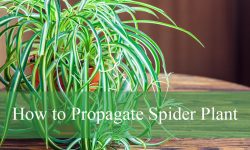Succulents are among the most diverse and low-maintenance plants, making them a favorite for gardeners and houseplant enthusiasts alike. With their thick, fleshy leaves and ability to store water, these plants thrive in dry conditions and require minimal care. From small, delicate rosettes to towering, spiky varieties, the many types of succulents offer a stunning range of colors, shapes, and textures.
Whether you’re looking for a hardy outdoor succulent or a striking indoor plant, there’s a perfect variety for every setting. Some types of succulents grow in compact clusters, while others trail beautifully from hanging pots. Many even produce unique flowers, adding seasonal beauty to their already fascinating appearance. Understanding their characteristics and care needs can help you choose the right plant for your home or garden.
In this guide, we’ll explore 75 common types of succulents, complete with pictures and names to help you identify them. From well-known classics like Aloe Vera and Jade Plant to rare and exotic species, this comprehensive list will introduce you to the incredible diversity of succulents.
Different Types of Succulents
String of Pearls (Senecio rowleyanus)
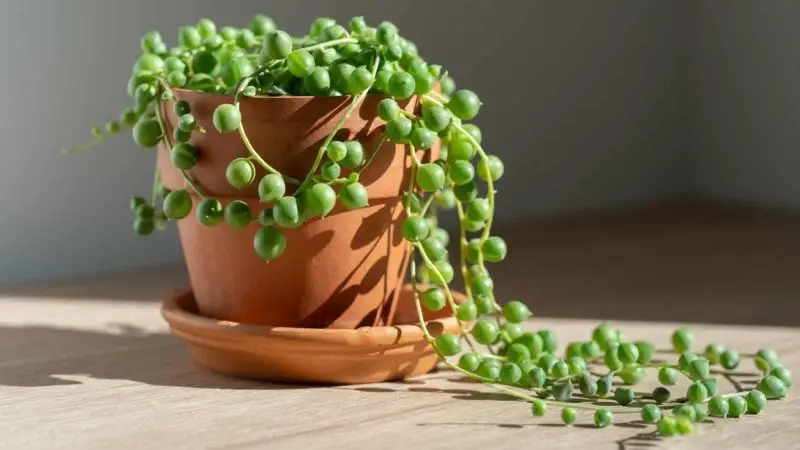
String of Pearls is a trailing succulent with long, slender stems adorned with round, pearl-like green leaves. This plant creates an elegant cascading effect, making it ideal for hanging baskets or shelf displays.
It thrives in full to partial sun and requires sandy, well-draining soil. Watering should be infrequent, as the small, bead-like leaves store water efficiently. Overwatering can lead to root rot, so it’s best to let the soil dry completely between waterings.
String of Pearls grows well in USDA Zones 9-12. In colder climates, it should be kept indoors or in a greenhouse where it can receive adequate light and warmth.
Candelabra Cactus (Euphorbia ingens)
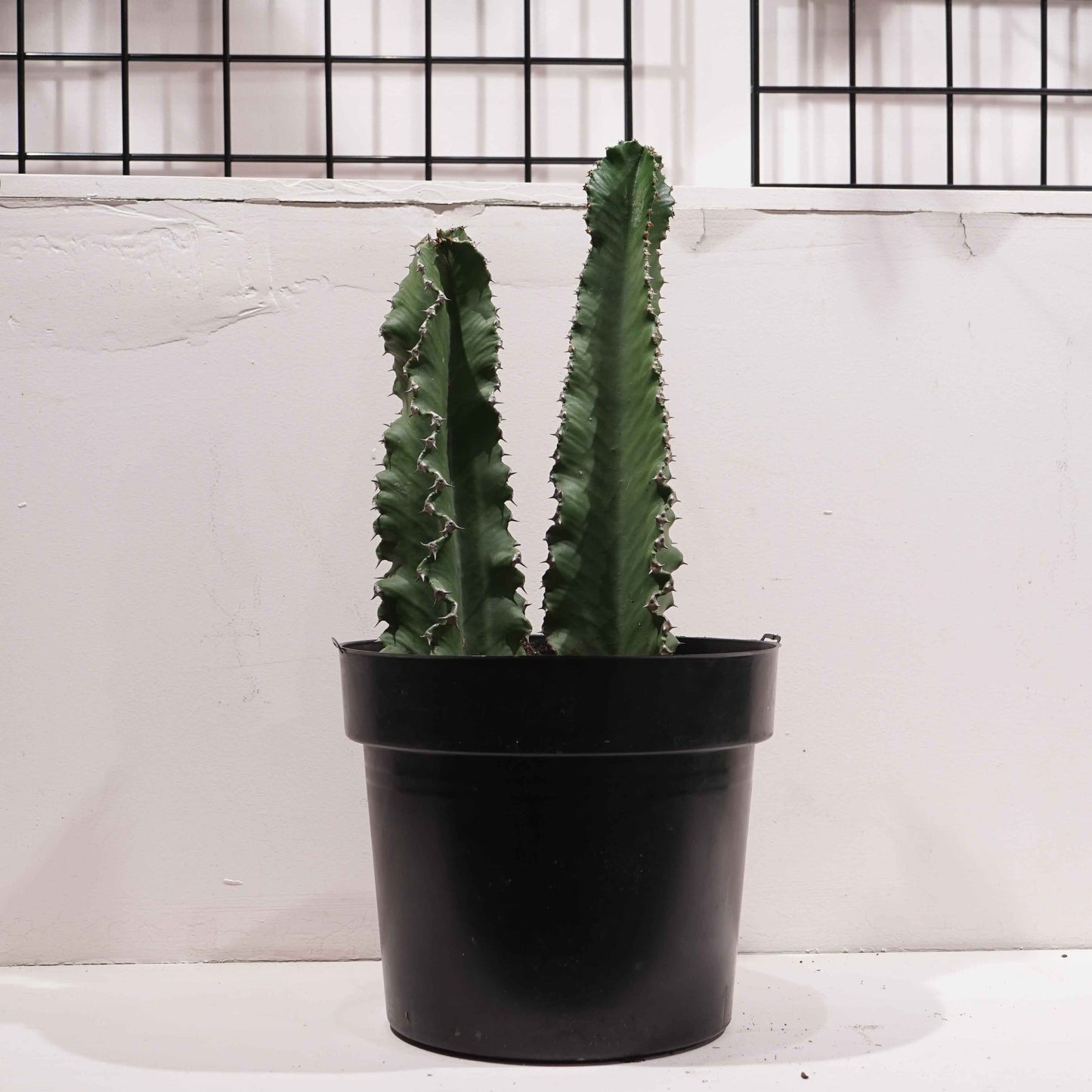
The Candelabra Cactus is a striking columnar succulent with dark green, four-lobed stems that can grow up to 40 feet tall when planted outdoors. Its towering structure and branching arms resemble a traditional candelabra, giving the plant its name. Despite its cactus-like appearance, it belongs to the Euphorbia genus and contains a milky sap that can be toxic if handled improperly.
This plant thrives in full sun and requires sandy, well-draining soil to prevent root rot. It has very low water needs and should only be watered sparingly, allowing the soil to dry completely between waterings. Overwatering can lead to fungal infections and other issues.
Candelabra Cactus is best suited for USDA Zones 10-11, where it can be grown outdoors year-round. In cooler climates, it should be kept in containers and brought indoors during colder months.
Crown of Thorns (Euphorbia milii)
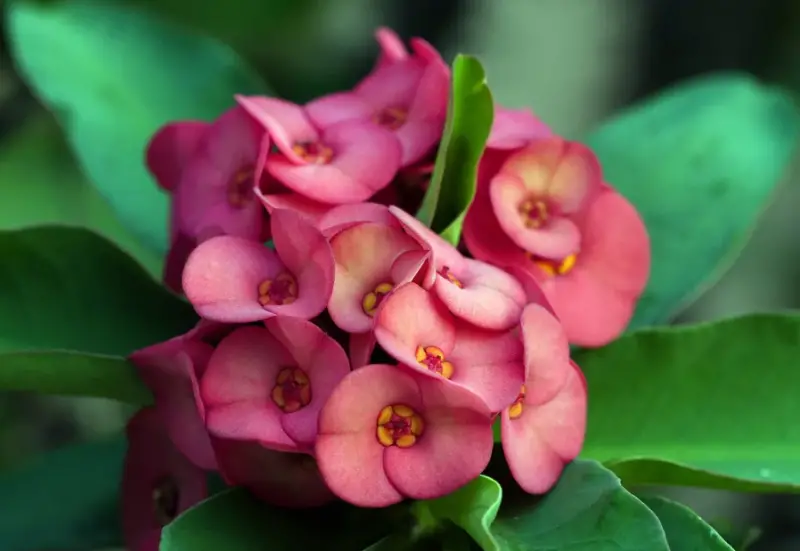
Crown of Thorns is a unique thorny succulent with thick green leaves and vibrant, petal-like bracts that surround small flowers. The plant gets its name from its sharp spines, which cover its stems and help deter herbivores. With proper care, it can bloom throughout the year, making it a popular ornamental choice.
It prefers full to partial sun and thrives in well-draining soil. Watering should be kept minimal, as excessive moisture can cause root rot. Crown of Thorns is highly drought-tolerant and can survive periods of dryness, making it ideal for low-maintenance gardens.
This plant is well-suited for USDA Zones 9-11. In colder regions, it should be grown indoors or in a greenhouse to protect it from frost.
Aloe Vera (Aloe barbadensis miller)
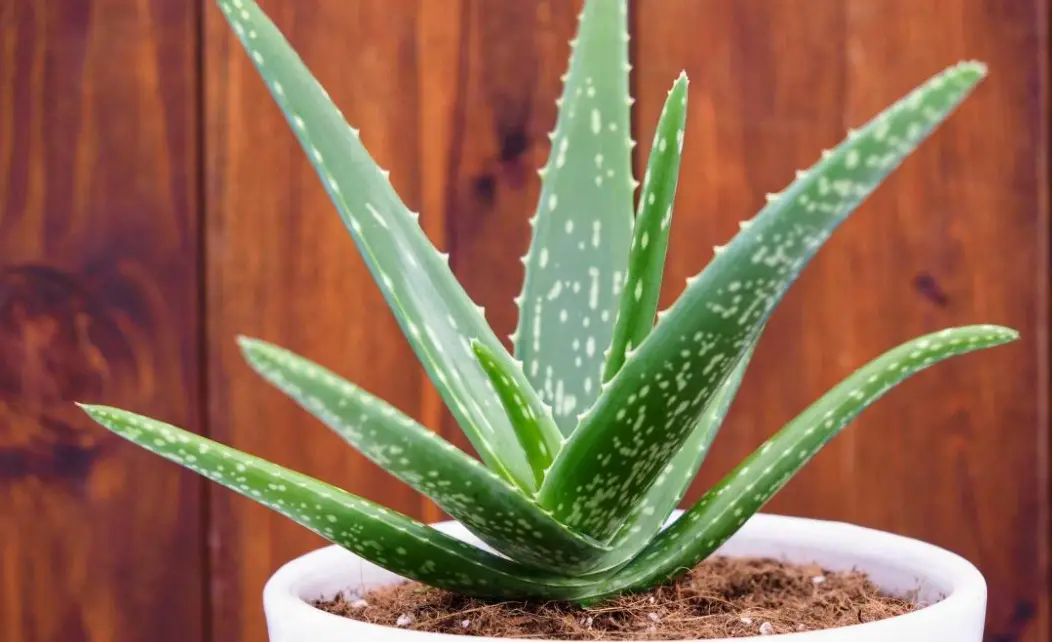
Aloe Vera is a well-known succulent prized for its thick, fleshy leaves filled with a soothing gel used for medicinal and skincare purposes. Its serrated leaf edges and rosette growth pattern give it a distinctive appearance, and mature plants may produce tall flower spikes with yellow or orange blooms.
This plant thrives in bright light and sandy, well-draining soil. It requires regular watering during its active growing season but should be watered sparingly during dormancy to prevent root rot. Aloe Vera is highly resilient and can tolerate drought conditions.
Aloe Vera is best suited for USDA Zones 10-12, where it can be grown outdoors. In cooler climates, it should be kept indoors near a sunny window to maintain optimal growth conditions.
Christmas Cactus (Schlumbergera x buckleyi)
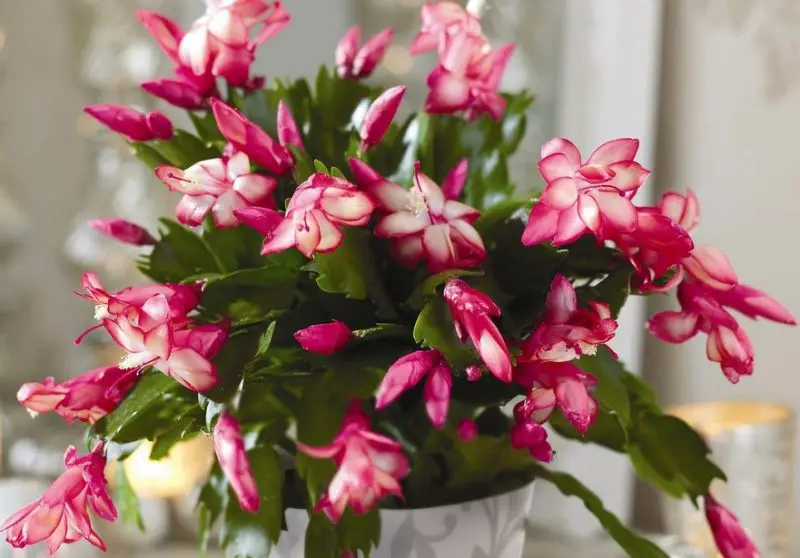
Christmas Cactus is a beloved holiday plant known for its flattened, segmented leaves and vibrant, tubular flowers that bloom in winter. Unlike most succulents, it does not store water in thick leaves but instead relies on its epiphytic nature to absorb moisture from the air.
This plant prefers partial shade and grows best in loamy, well-draining soil. It requires moderate watering, keeping the soil slightly moist but never soggy. Unlike desert cacti, it thrives in humid conditions and benefits from occasional misting.
Christmas Cactus grows best in USDA Zones 10-12. In cooler regions, it should be kept indoors in bright, indirect light to encourage healthy blooming.
Jade Plant (Crassula ovata)
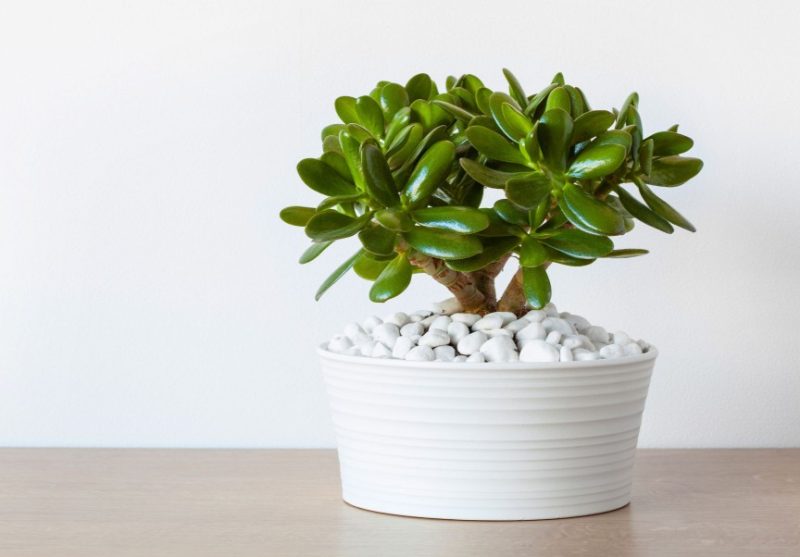
Jade Plant is a popular succulent known for its thick, woody stems and fleshy, oval-shaped green leaves. It can grow up to 6 feet tall indoors, developing a tree-like appearance over time. With proper care, mature plants may produce small pink or white star-shaped flowers.
This succulent thrives in bright, indirect light and should be planted in well-draining soil to prevent root rot. It requires moderate watering, allowing the soil to dry out completely between waterings. During winter, watering should be reduced to prevent overhydration.
Jade Plant is best suited for USDA Zones 11-12, where it can grow outdoors year-round. In cooler climates, it should be kept indoors or in containers that can be moved inside during colder months.
Silver Dollar Plant (Crassula arborescens)

The Silver Dollar Plant is a multi-stemmed succulent shrub with striking blue-gray, rounded leaves that have a maroon edge. The thick, fleshy leaves store water, making this plant highly drought-tolerant. It can grow up to 4 feet tall and produces small pink or white flowers in the right conditions.
This succulent thrives in bright, indirect light but can tolerate some direct sun. It requires well-draining soil and minimal watering, as excess moisture can lead to root rot. During winter, watering should be reduced significantly.
Silver Dollar Plant is ideal for USDA Zones 10-12, where it can be grown outdoors in warm climates. In cooler regions, it is best kept in pots that can be brought indoors during colder months.
Donkey’s Tail (Sedum morganianum)
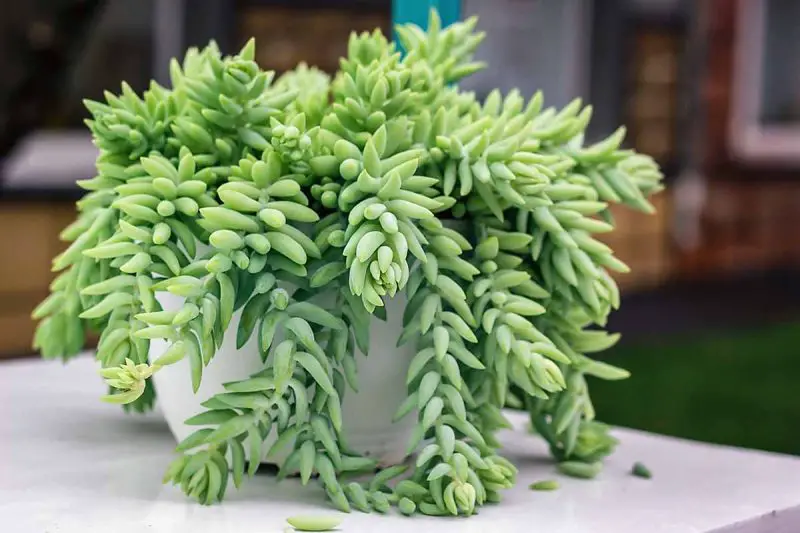
Donkey’s Tail is a trailing succulent known for its cascading stems covered in rows of blue-green, tear-drop-shaped leaves. The delicate leaves break easily when touched, making it a fragile but beautiful plant for hanging baskets.
It prefers full to partial sun and thrives in well-draining loamy or sandy soil. This succulent has low water needs and should only be watered when the soil is completely dry. Overwatering can cause the leaves to become mushy and fall off.
This plant is best suited for USDA Zones 10-11, where it can be grown outdoors. In colder climates, it should be grown indoors in a bright location to protect it from frost.
Mexican Snowballs (Echeveria elegans)
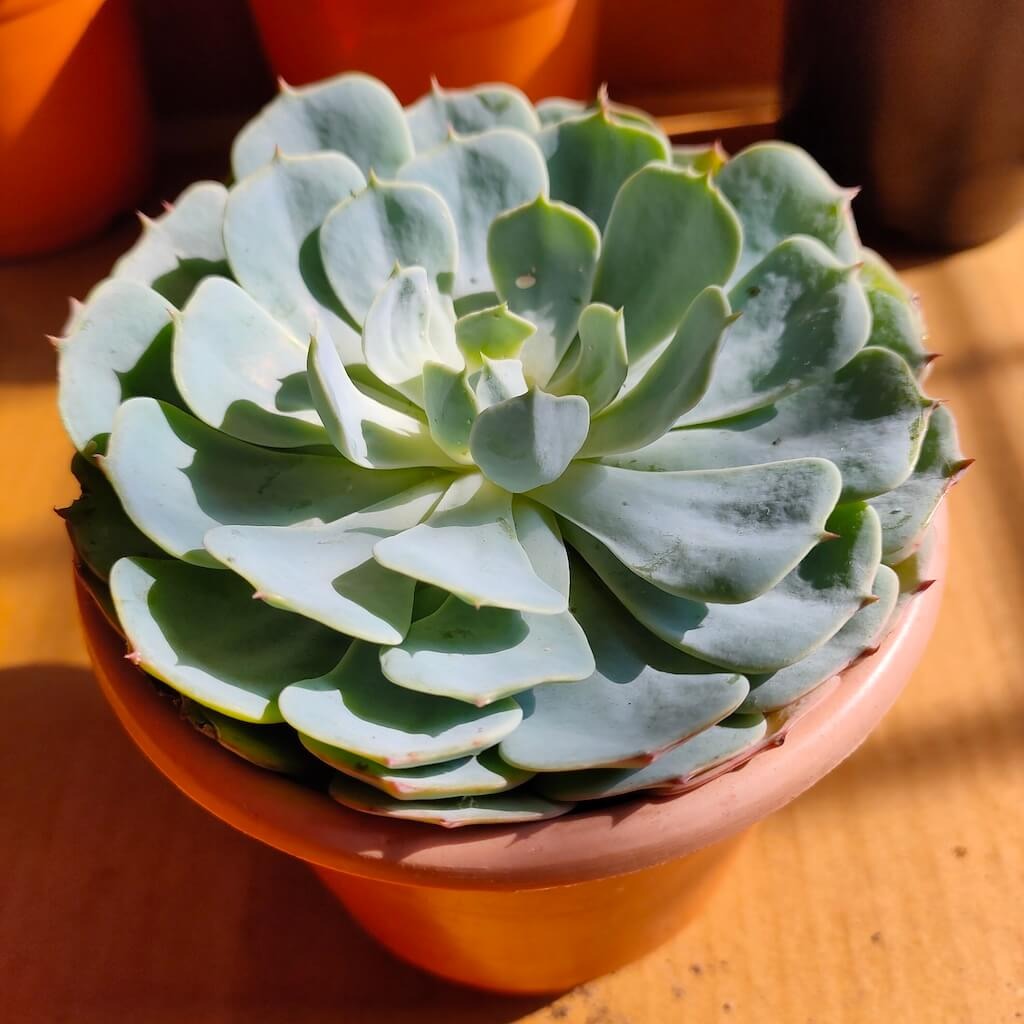
Mexican Snowballs is a beautiful rosette-shaped succulent with fleshy silver-green leaves. Over time, it forms dense clusters and produces delicate pink flowers on tall stalks during the growing season.
This succulent thrives in full sun and requires sandy, well-draining soil to prevent root rot. It has minimal water needs and should only be watered when the soil is completely dry. Overwatering can lead to leaf rot and other issues.
Mexican Snowballs grow best in USDA Zones 9-11. In cooler climates, they should be grown in containers or indoors, where they can receive plenty of sunlight and stay protected from frost.
Echeveria ‘Perle von Nurnberg’
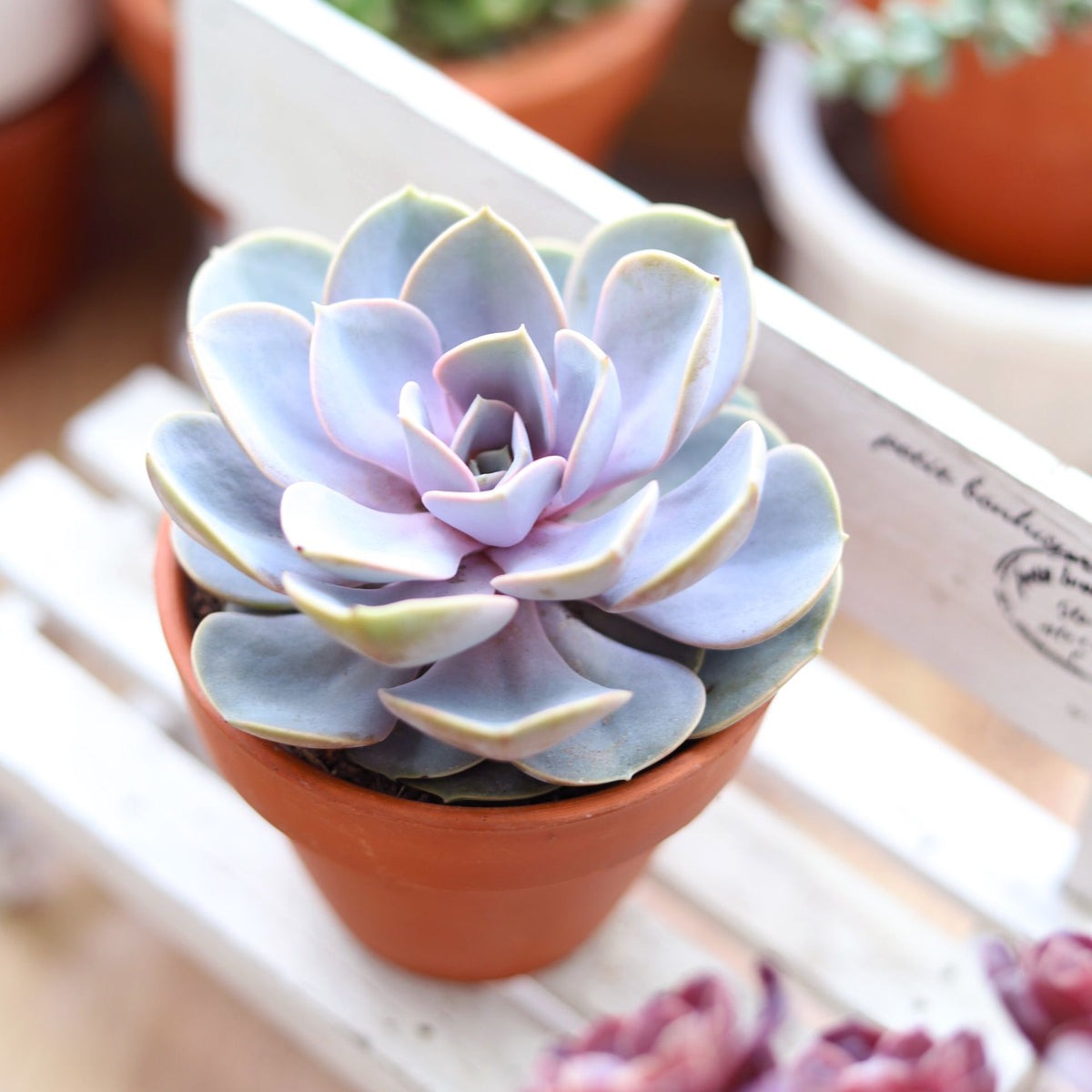
Echeveria ‘Perle von Nurnberg’ is a stunning rosette-shaped succulent with pastel-colored leaves that develop bright purple and pink hues when exposed to full sun. This variety is a hybrid, known for its elegant appearance and fast growth.
It thrives in bright light and requires well-draining soil to prevent excess moisture retention. Watering should be done sparingly, allowing the soil to dry out between waterings. This plant is highly drought-tolerant and does not require frequent maintenance.
Best suited for USDA Zones 9-12, Echeveria ‘Perle von Nurnberg’ can be grown outdoors in warm climates. In colder areas, it should be kept in pots and moved indoors during frosty weather.
Chocolate Soldier Plant (Kalanchoe tomentosa)
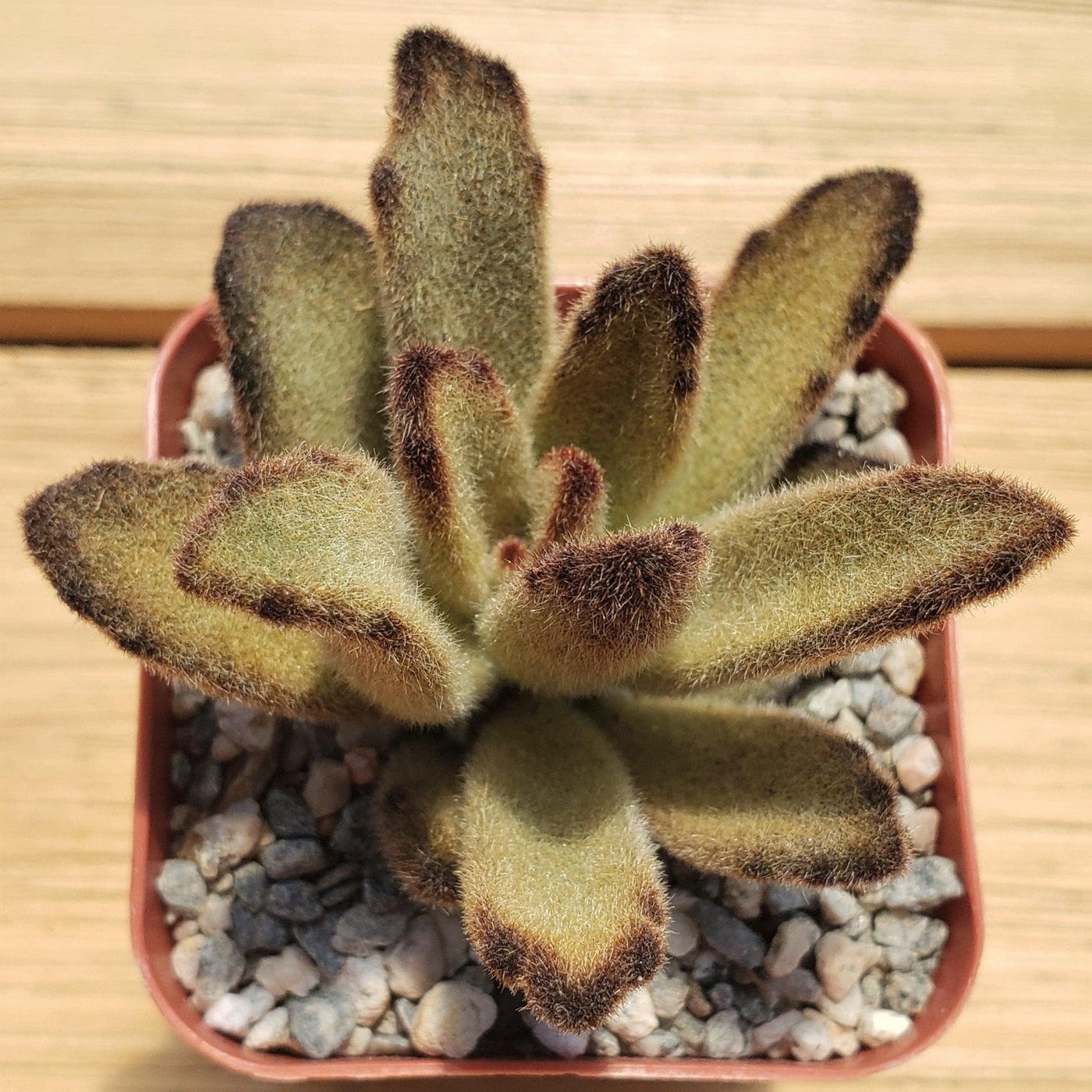
The Chocolate Soldier Plant is a fuzzy succulent with pale green leaves covered in fine, velvety hairs and rimmed with distinctive chocolate-brown spots. Its soft texture and compact growth make it an attractive houseplant, often grown in small containers.
It requires bright indirect light and thrives in well-draining soil. Watering should be kept minimal, as this plant is highly drought-tolerant and prone to root rot if overwatered. Let the soil dry completely between waterings to maintain optimal health.
This succulent is ideal for USDA Zones 9a-11b. In colder climates, it should be kept indoors near a bright window to prevent exposure to frost.
Flapjack (Kalanchoe luciae)
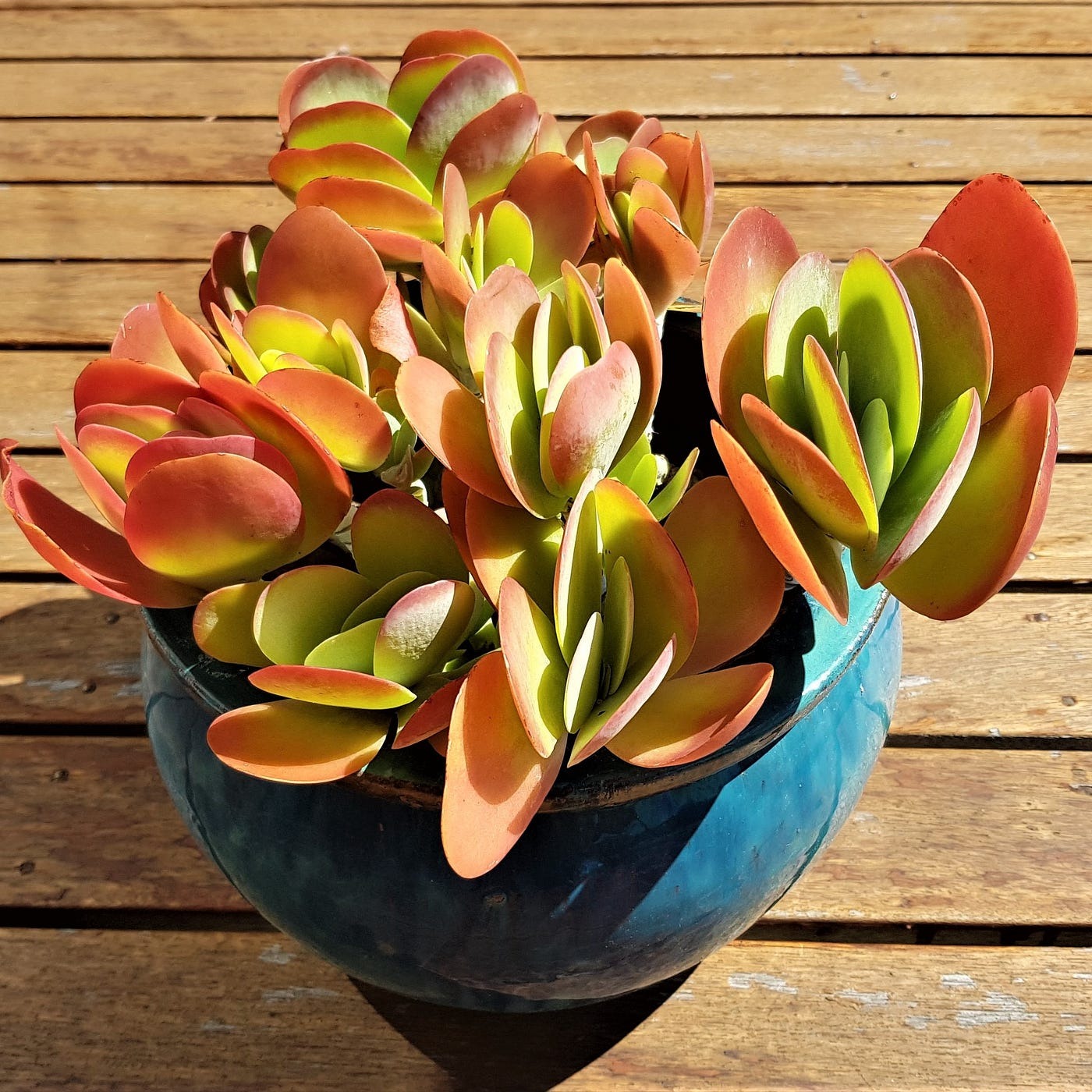
Flapjack is a striking succulent with paddle-shaped leaves that form rosette clusters. When exposed to full sunlight, the leaves develop a red-tinged hue, making it a visually appealing addition to any succulent garden. It produces tall flower spikes in late winter or early spring.
This plant thrives in full to partial sun and prefers sandy, well-draining soil. It has low water needs and should only be watered when the soil is completely dry. Overwatering can cause root rot and leaf damage.
Flapjack grows best in USDA Zones 9-11. In colder regions, it should be kept in pots that can be moved indoors during winter to protect it from frost.
Flaming Katy (Kalanchoe blossfeldiana)
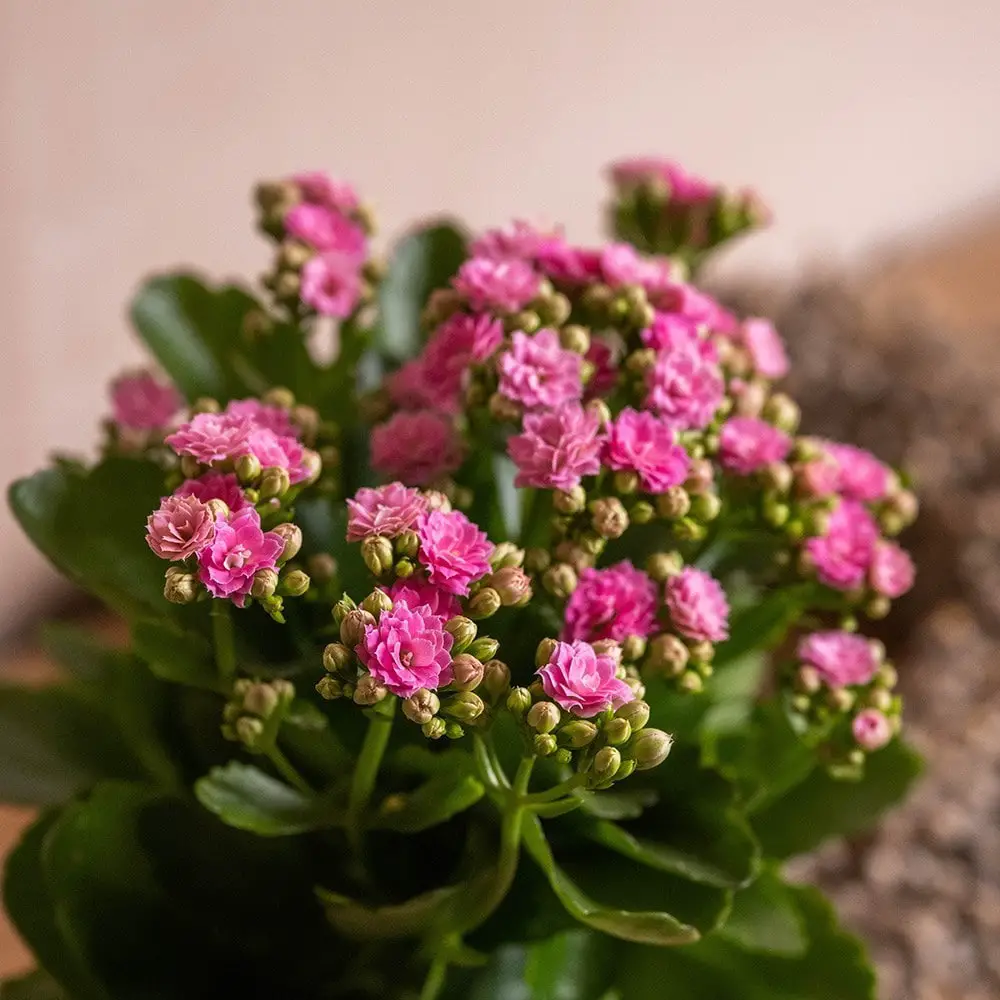
Flaming Katy is a compact succulent known for its scallop-edged green leaves and repeated blooming flowers in vibrant shades of red, pink, orange, and yellow. This plant is popular as a decorative houseplant, especially during the winter months when its flowers add a splash of color indoors.
It grows best in bright light and requires sandy, well-draining soil to prevent root rot. Watering should be minimal, allowing the soil to dry out completely between waterings. Overwatering can lead to fungal infections and leaf drop.
Flaming Katy is well-suited for USDA Zones 10-12, where it can be grown outdoors in warm climates. In cooler regions, it should be kept indoors or in containers that can be moved inside during cold weather.
Ponytail Palm (Beaucarnea recurvata)
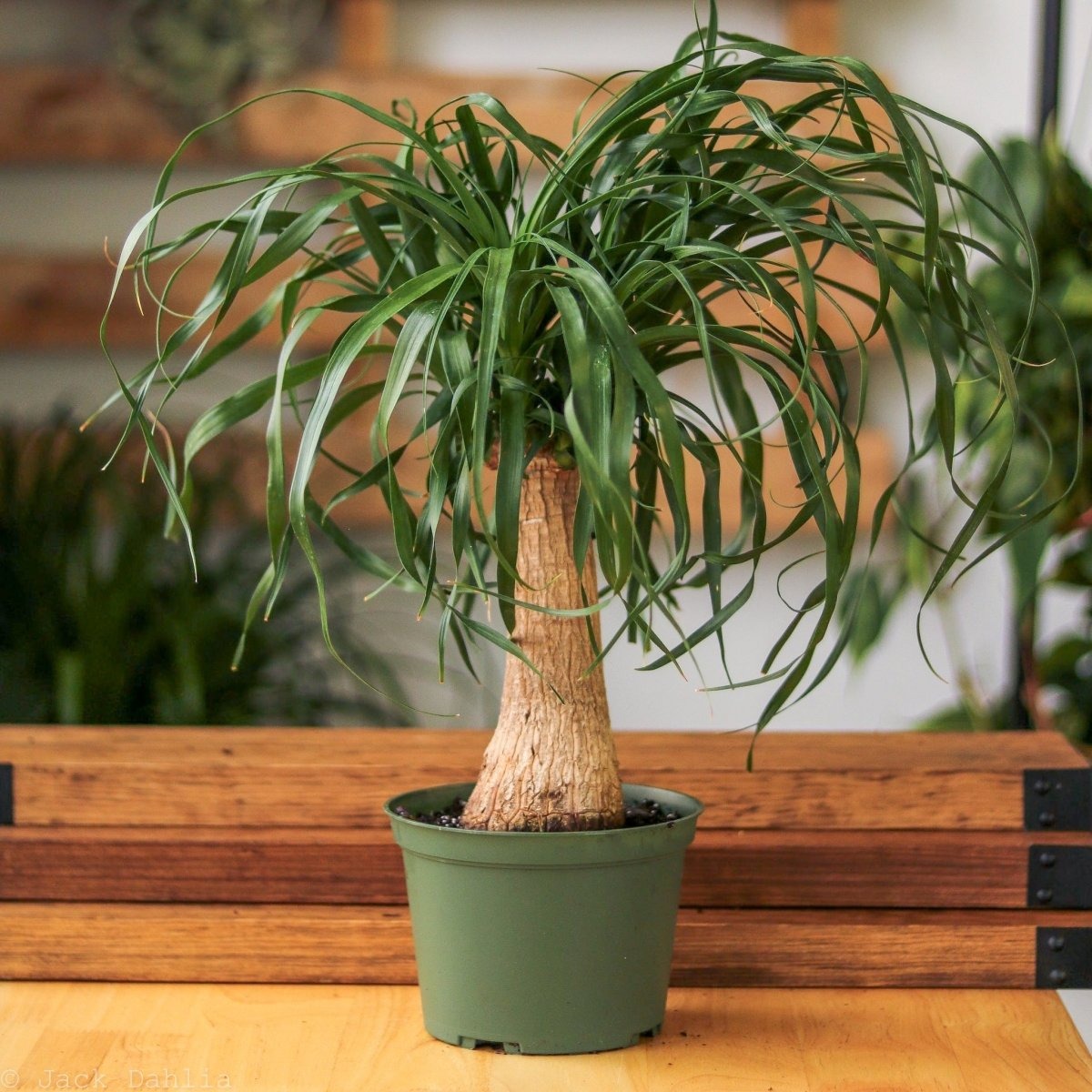
The Ponytail Palm is an eye-catching succulent with a thick, bulbous base that stores water and long, thin, strap-like leaves that resemble a palm tree. Despite its name, it is not a true palm but belongs to the Asparagaceae family. This slow-growing plant can reach up to 10 feet tall indoors and even taller in outdoor landscapes.
It thrives in full sun and requires sandy, well-draining soil to prevent moisture buildup. Watering should be infrequent, with occasional deep watering to encourage root growth. The plant is highly drought-tolerant and can withstand long periods without water.
Ponytail Palm is best suited for USDA Zones 10-11. In cooler climates, it should be grown indoors in a bright, sunny spot and protected from frost.
Snake Plant (Dracaena trifasciata)
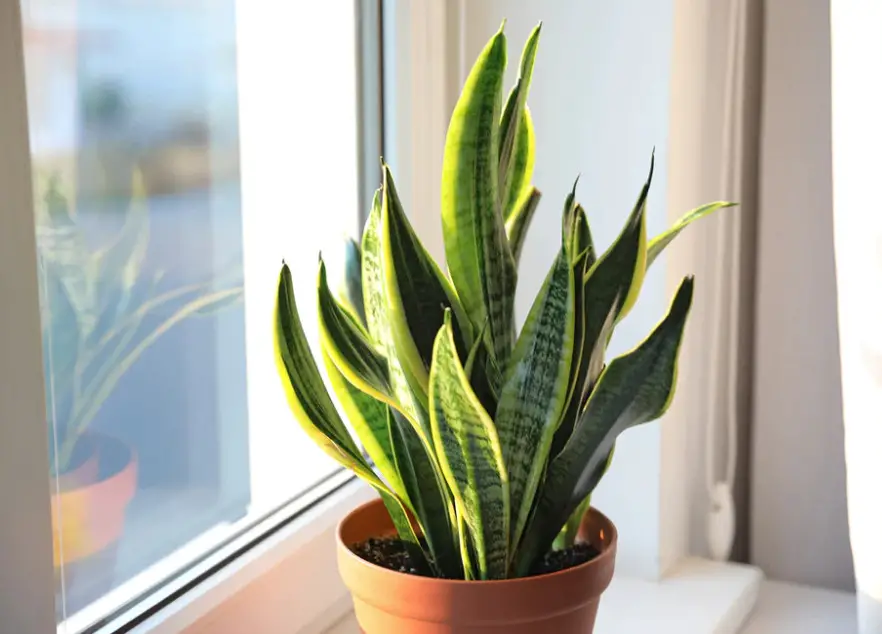
Snake Plant is a hardy succulent with upright, sword-like leaves featuring green and yellow variegation. Known for its air-purifying properties, this plant is highly resilient and can thrive in various indoor conditions, making it a popular choice for homes and offices.
It thrives in indirect light but can tolerate some direct sun. Sandy, well-draining soil is essential to prevent root rot, and watering should be minimal, as the plant can store moisture in its thick leaves. Overwatering is the most common issue with this otherwise low-maintenance plant.
Snake Plant grows best in USDA Zones 9-11, where it can be kept outdoors in warm climates. In colder areas, it should be grown indoors and protected from freezing temperatures.
Zebra Haworthia (Haworthia fasciata)
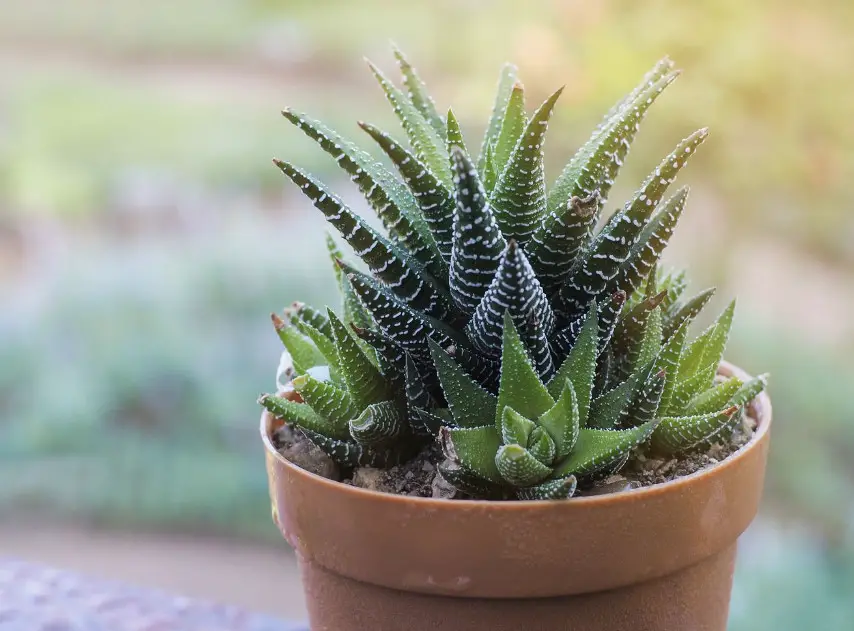
Zebra Haworthia is a small, compact succulent with dark green leaves adorned with white horizontal stripes, giving it a striking appearance. This slow-growing plant remains small, making it an excellent choice for tabletops and windowsills.
It prefers bright, indirect light and thrives in sandy, well-draining soil. Watering should be done sparingly, allowing the soil to dry out completely between waterings. Like most succulents, overwatering can lead to root rot and other health issues.
Zebra Haworthia is ideal for USDA Zones 9-11. In colder climates, it should be kept indoors in a well-lit area to ensure healthy growth.
Mother of Thousands (Kalanchoe daigremontiana)
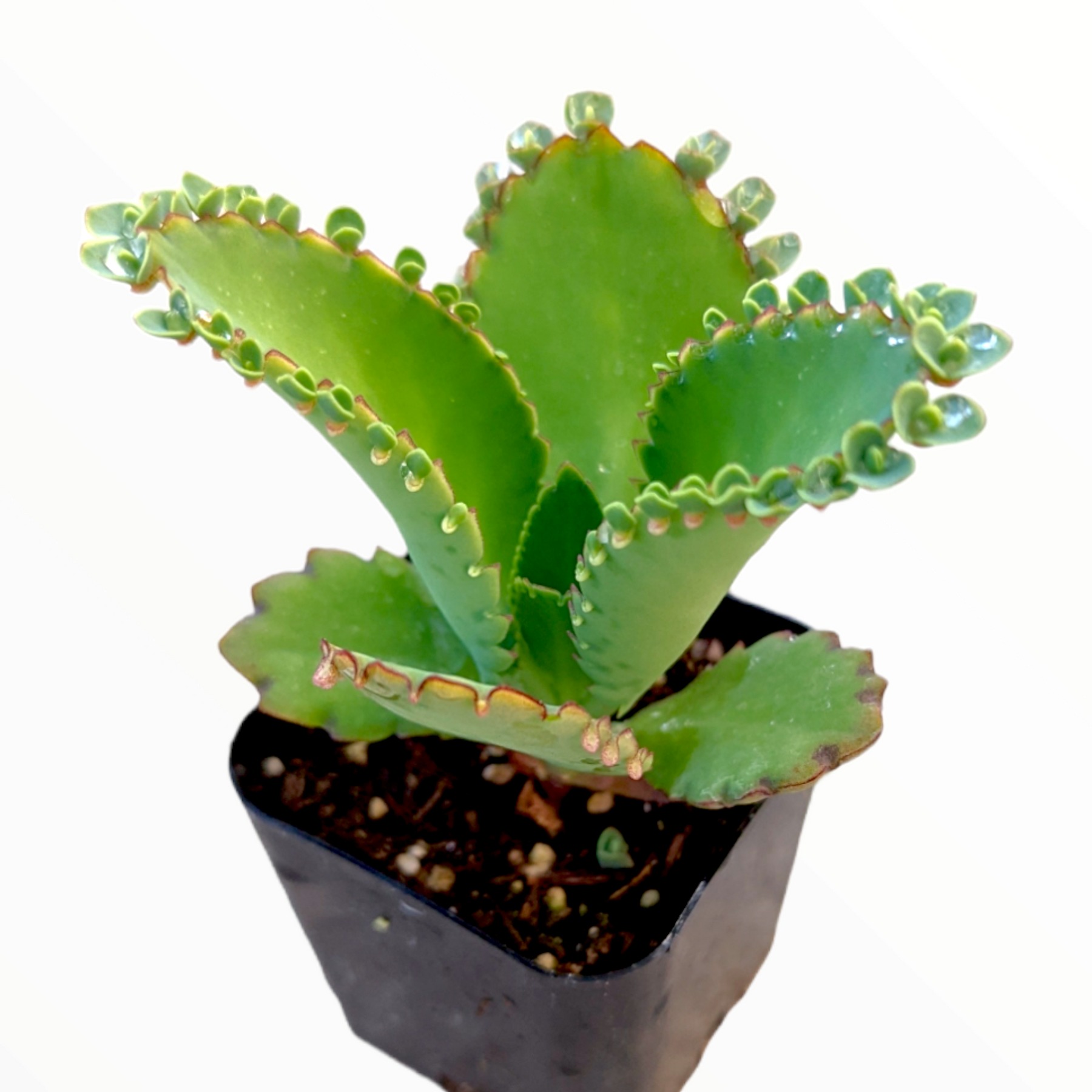
Mother of Thousands is a unique succulent with serrated leaves that produce tiny baby plantlets along the edges. These plantlets eventually drop off and root in the soil, allowing the plant to spread easily.
It requires indirect light indoors or partial sun outdoors and thrives in well-draining soil. Watering should be moderate, ensuring the soil dries out between waterings to prevent root rot. This plant is fast-growing and can quickly take over an area if not controlled.
Best suited for USDA Zones 9-11, Mother of Thousands can be grown outdoors in warm climates. In cooler regions, it is best kept as a houseplant to protect it from frost.
Pink Quill (Tillandsia cyanea)
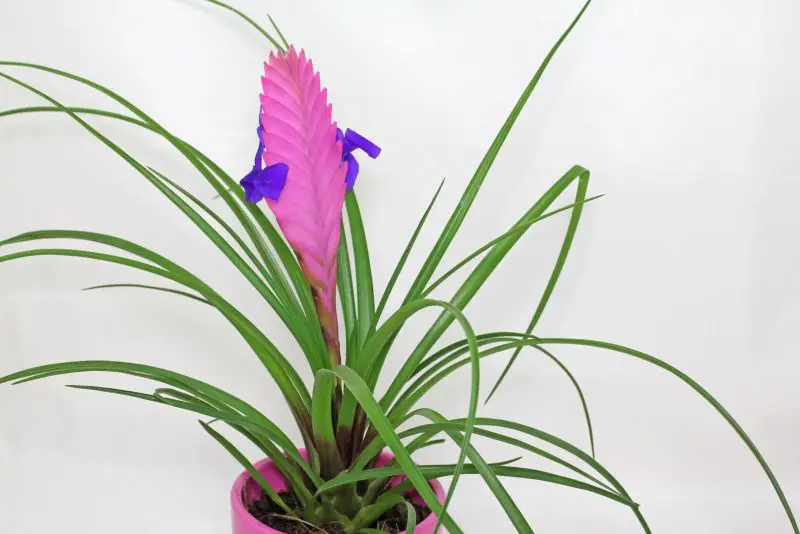
Pink Quill is a stunning air plant known for its bright pink bracts that resemble quills, which later produce small purple flowers. Unlike most succulents, it absorbs moisture and nutrients through its leaves rather than its roots, making it an epiphytic plant.
It thrives in partial sun and requires well-draining soil. Watering should be minimal, as the plant absorbs humidity from the air. Misting occasionally can help maintain adequate moisture levels, but overwatering should be avoided.
Pink Quill grows best in USDA Zones 9-12. In cooler climates, it should be kept indoors in a warm, humid environment to ensure healthy growth.
Ghost Plant (Graptopetalum paraguayense)
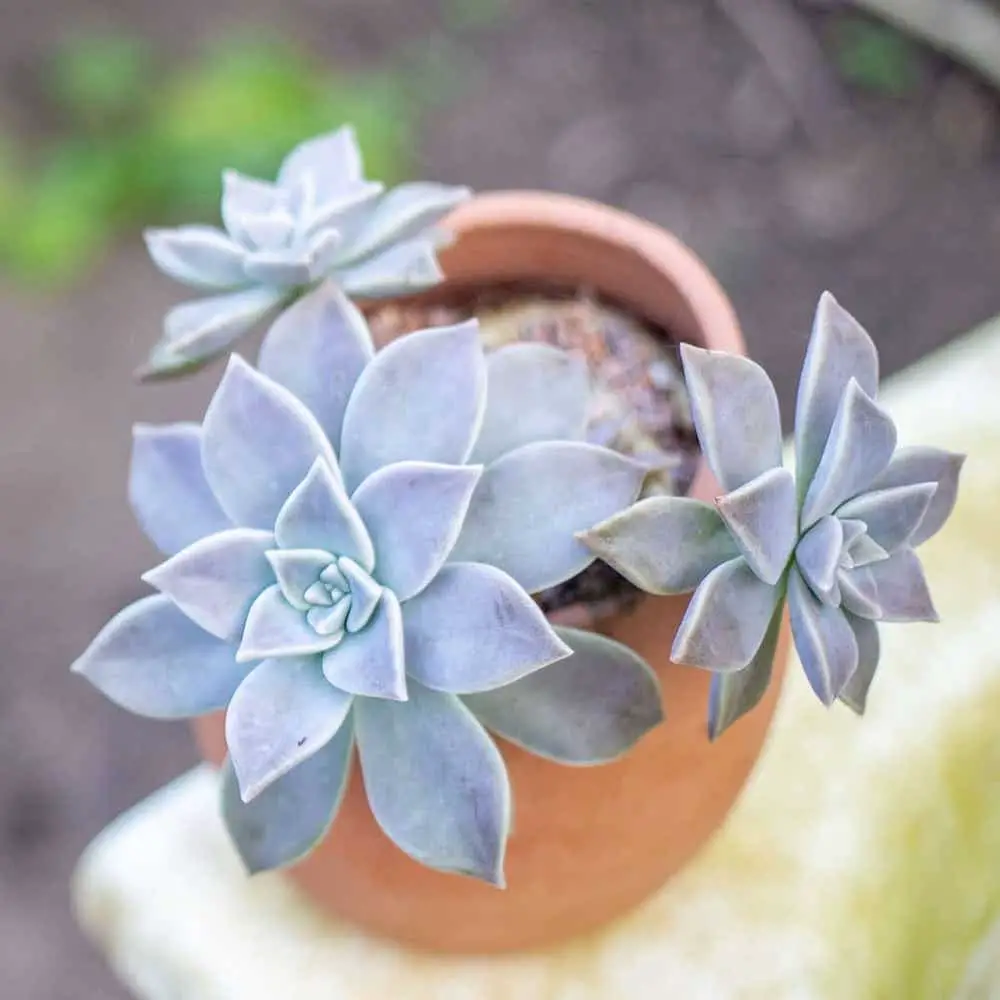
Ghost Plant is a trailing succulent known for its beautiful rosette formations and whitish-gray, slightly pinkish leaves. The foliage changes color depending on sunlight exposure, shifting from pale blue to soft pink under bright conditions. This plant is fast-growing and easy to propagate from fallen leaves.
It thrives in full to partial sun and prefers sandy, well-drained soil to prevent root rot. Watering should be minimal, allowing the soil to dry out completely between waterings. Overwatering can lead to leaf drop and fungal infections.
Ghost Plant is best suited for USDA Zones 9-11, where it can be grown outdoors. In cooler climates, it should be kept indoors or in containers that can be moved inside during winter.
Jelly Bean Succulents (Sedum rubrotinctum)
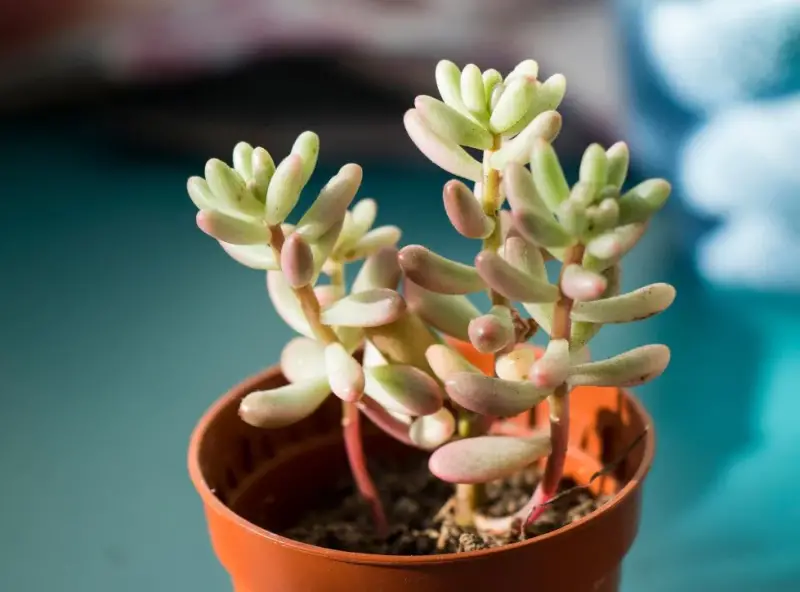
Jelly Bean Succulents are low-growing sedums with plump, jelly bean-shaped leaves that transition from green to reddish-orange in bright sunlight. Their playful appearance makes them a popular choice for succulent arrangements and rock gardens.
These succulents require full sun for the best coloration and grow best in sandy, well-draining soil. Watering should be minimal, as excessive moisture can cause the leaves to drop or become mushy. They are drought-tolerant and can survive with occasional deep watering.
Best suited for USDA Zones 9-11, Jelly Bean Succulents can be grown outdoors year-round in warm climates. In colder regions, they should be brought indoors during frost.
Living Stones (Lithops spp.)
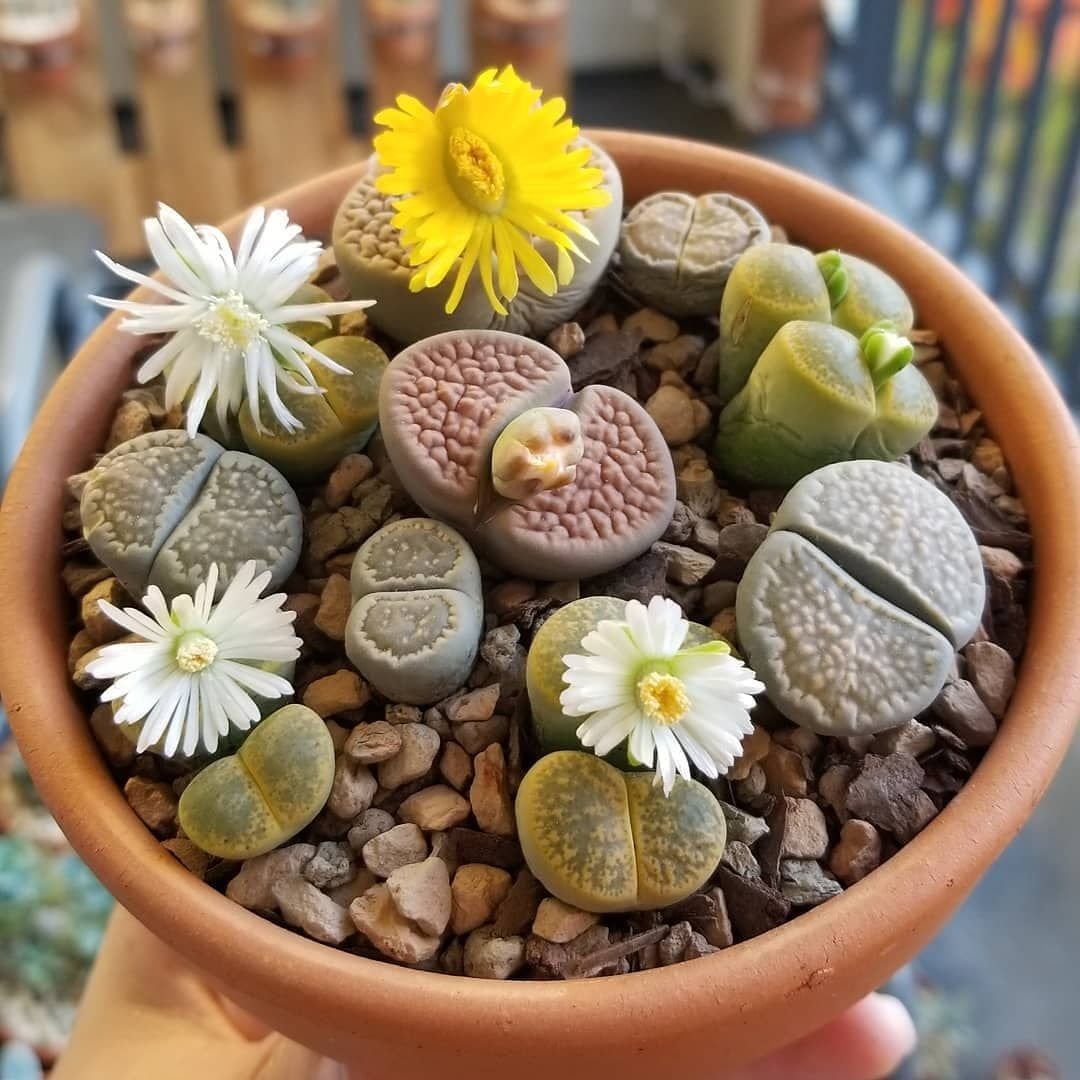
Living Stones are fascinating succulents that resemble small, rounded pebbles, helping them blend seamlessly into rocky landscapes. They grow in clusters, with each “stone” consisting of two fleshy leaves separated by a fissure where new growth and flowers emerge.
These plants need full sun and sandy, well-draining soil to mimic their natural desert habitat. Watering should be extremely minimal, with long dry periods, as excessive moisture can cause them to rot. They enter dormancy in summer, during which they should not be watered at all.
Living Stones thrive in USDA Zones 10-11. In cooler climates, they should be kept indoors in a bright, warm spot to ensure healthy growth.
Hens and Chicks (Sempervivum tectorum)
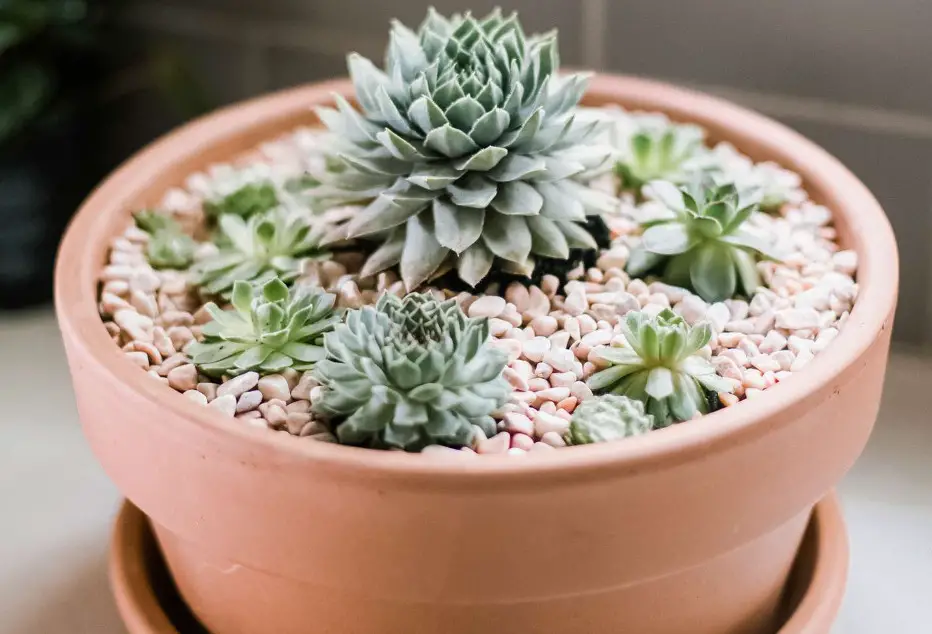
Hens and Chicks is a hardy succulent known for its rosette growth pattern, where the central “hen” produces multiple small offsets or “chicks.” The plant displays various colors, from green to deep red, depending on sunlight exposure.
This succulent prefers full sun and thrives in sandy, well-draining soil. It requires low watering, as too much moisture can lead to root rot. The offsets can be easily removed and replanted to propagate new plants.
Hens and Chicks are well-adapted to USDA Zones 3-11, making them one of the most cold-hardy succulents. They can withstand freezing temperatures and grow well in rock gardens and outdoor containers.
Parry’s Agave (Agave parryi)
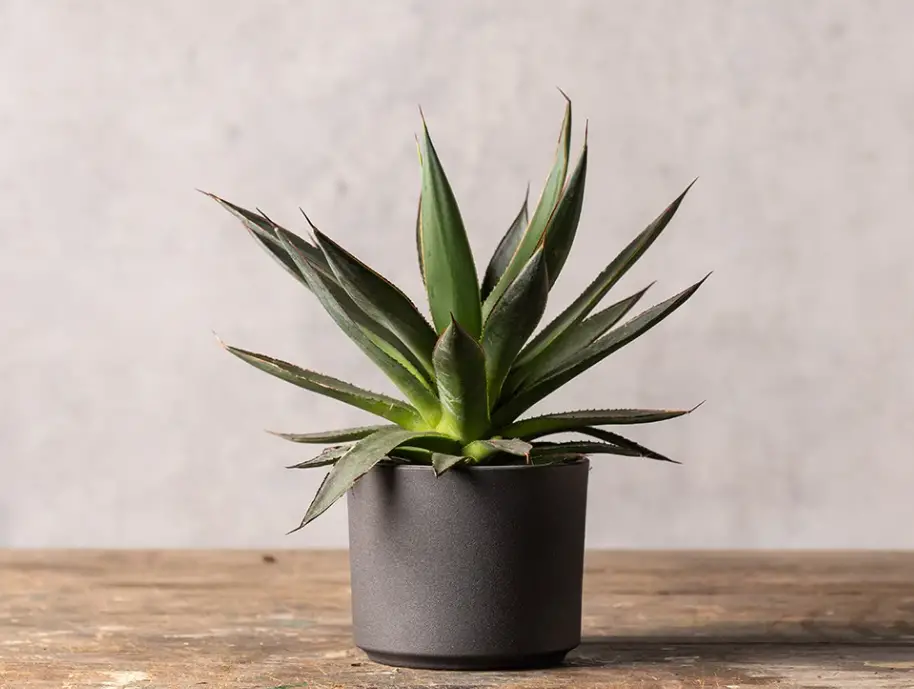
Parry’s Agave is a striking succulent featuring thick, spiky, slate-gray leaves arranged in a symmetrical rosette. This slow-growing plant adds a bold architectural element to xeriscapes and desert gardens, producing a tall flowering stalk once in its lifetime.
It thrives in full sun and requires sandy, well-drained soil. Watering should be moderate, allowing the soil to dry out between watering sessions. Once established, it is highly drought-tolerant and can survive with minimal care.
Parry’s Agave is best suited for USDA Zones 7-10. It can withstand occasional cold spells but should be protected from prolonged frost. In cooler climates, it is best grown in containers that can be brought indoors during winter.
Propeller Plant (Senecio crassissimus)
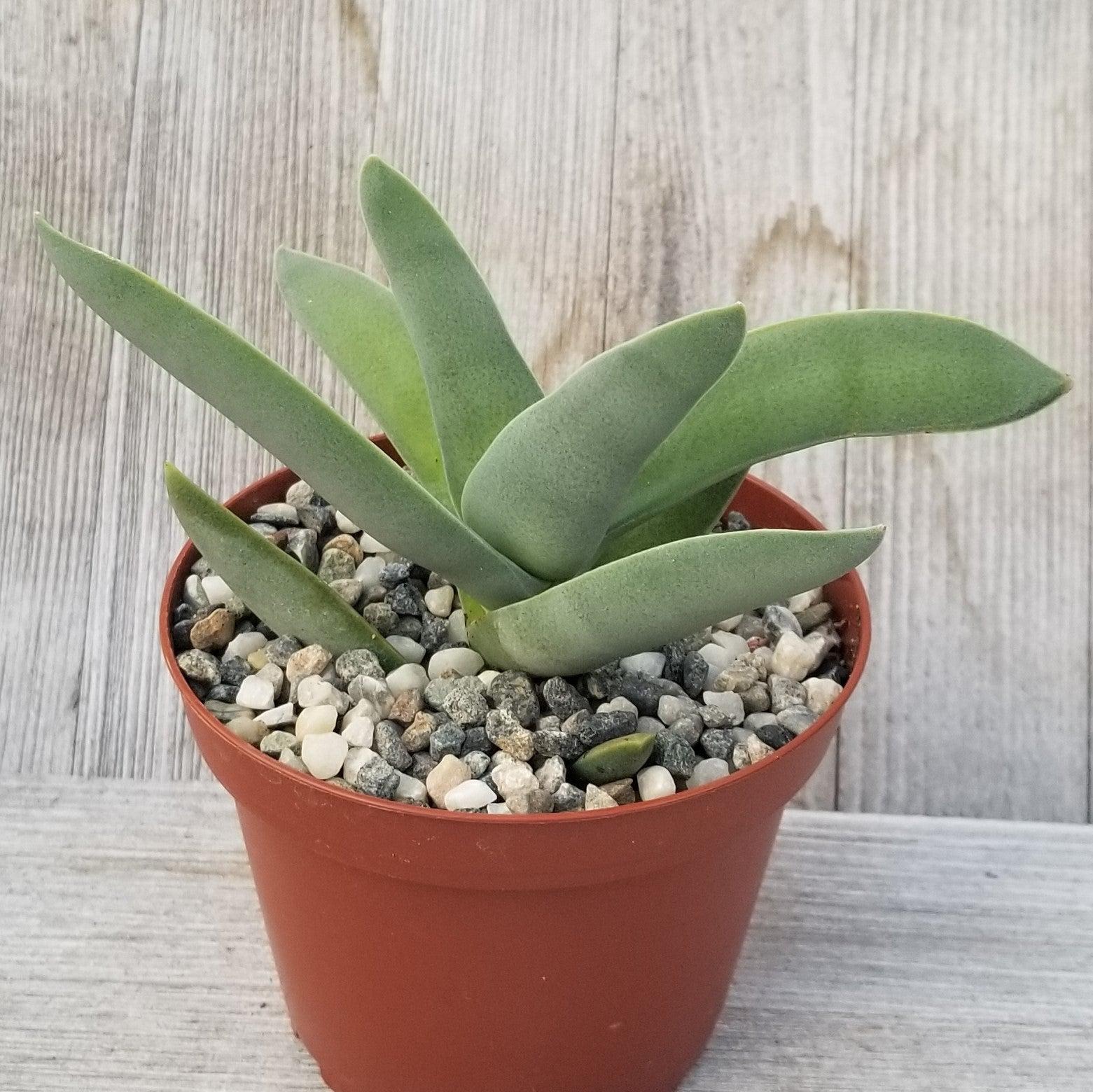
The Propeller Plant is an upright succulent with uniquely flattened, bluish-green leaves that grow in an alternating pattern, resembling airplane propellers. The foliage develops a purple tinge along the edges when exposed to bright sunlight.
This plant prefers full to partial sun and thrives in sandy, well-draining soil. Watering should be minimal, as it is highly drought-resistant. Overwatering can cause its stems to become weak and prone to rot.
Propeller Plant grows best in USDA Zones 10-11. In colder regions, it should be grown in pots that can be moved indoors during winter to protect it from frost.
Autumn Joy Stonecrop (Hylotelephium telephium ‘Autumn Joy’)
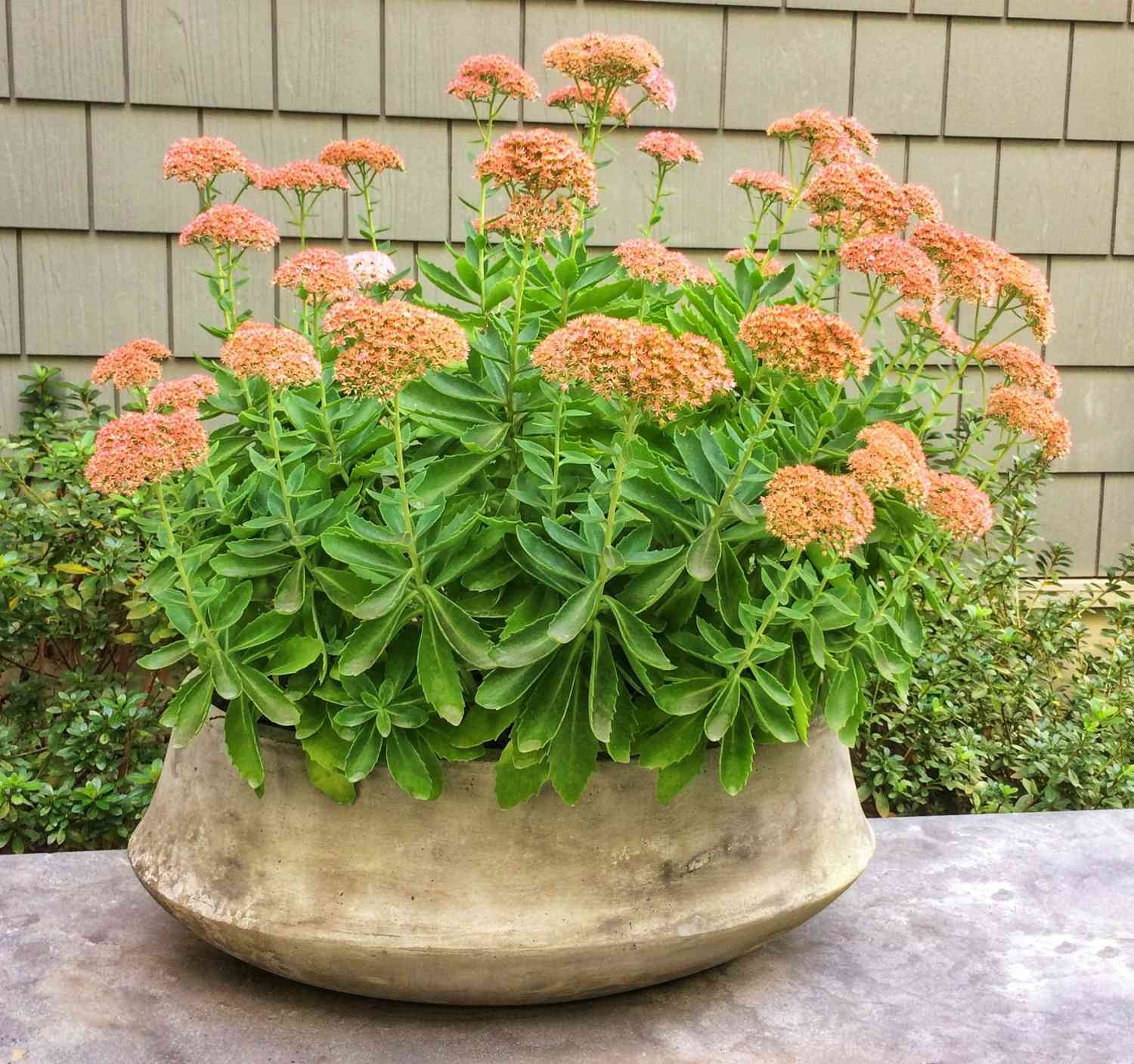
Autumn Joy Stonecrop is a clumping succulent known for its thick green leaves and late-season pink star-like flowers that mature into a coppery hue. Its upright growth and dense flower clusters make it a striking addition to gardens, particularly in fall when many other plants fade.
This resilient plant thrives in full sun and requires sandy, well-drained soil to prevent root rot. It is drought-tolerant and needs only occasional watering once established. Overwatering can cause leggy growth and reduce its longevity.
Ideal for USDA Zones 3-9, Autumn Joy Stonecrop is cold-hardy and can survive harsh winters. It works well in perennial beds, rock gardens, and xeriscaping designs.
Angelina Stonecrop (Sedum rupestre ‘Angelina’)

Angelina Stonecrop is a low-growing, spreading succulent with needle-like yellow-green leaves that turn orange in cool weather. Its dense, trailing habit makes it an excellent groundcover or cascading plant for containers and walls.
It thrives in full sun and prefers sandy, well-draining soil to maintain its compact growth. Watering should be minimal, as it is highly drought-tolerant. Too much moisture can cause rot or make it overly aggressive in growth.
With a USDA hardiness range of 3-11, Angelina Stonecrop is highly adaptable, capable of thriving in both cold and warm climates. It is widely used for erosion control and as a vibrant accent in rock gardens.
Panda Plant (Kalanchoe tomentosa ‘Chocolate Soldier’)

The Panda Plant is a unique succulent with fuzzy, grayish-green leaves edged with brown tips, resembling the fur of a panda. This slow-growing plant has a compact, bushy form and is often grown as a charming houseplant.
It prefers bright, indirect light and requires sandy, well-draining soil to prevent root rot. Watering should be occasional, allowing the soil to dry out completely between sessions. Overwatering can lead to leaf drop and fungal issues.
Best suited for USDA Zones 9-11, Panda Plant thrives in warm climates but is typically grown indoors in cooler regions. It is an excellent choice for decorative pots and low-maintenance indoor gardens.
Ice Plant (Delosperma cooperi)
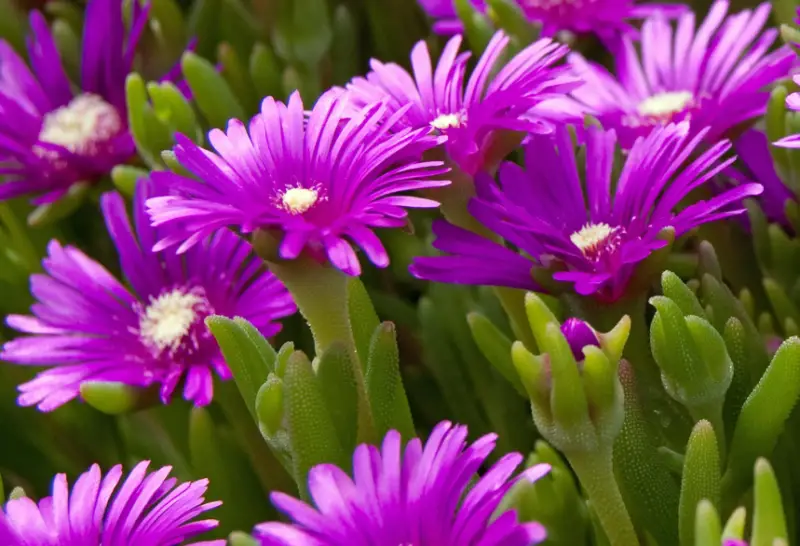
The Ice Plant is a spreading succulent with fleshy, evergreen leaves and vivid daisy-like flowers that bloom throughout summer and fall. The flowers shimmer in the sunlight, giving the plant its “icy” appearance.
This groundcover thrives in full sun and requires well-drained soil to prevent root rot. Once established, it needs very little water, making it an excellent drought-resistant option for arid landscapes.
Suitable for USDA Zones 5-10, Ice Plant can tolerate mild frost and is a popular choice for erosion control, rock gardens, and xeriscaping due to its resilience and vibrant display.
Blue Chalksticks (Senecio serpens)
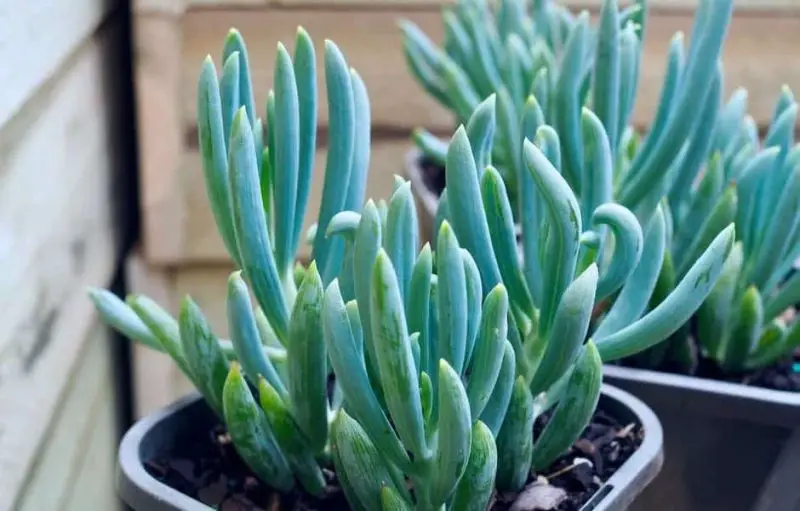
Blue Chalksticks is a low-growing, trailing succulent known for its powdery blue-green, cylindrical leaves. It forms dense mats, creating a striking contrast in succulent arrangements and rock gardens.
This plant needs full sun to maintain its vibrant color and prefers sandy, well-draining soil. Watering should be occasional, as overwatering can lead to root rot. It is highly tolerant of drought and thrives with minimal maintenance.
Best suited for USDA Zones 9-11, Blue Chalksticks grows well in warm climates and is often used as groundcover in dry landscapes. In cooler regions, it should be kept in containers and moved indoors during cold weather.
Tiger Jaws (Faucaria tigrina)
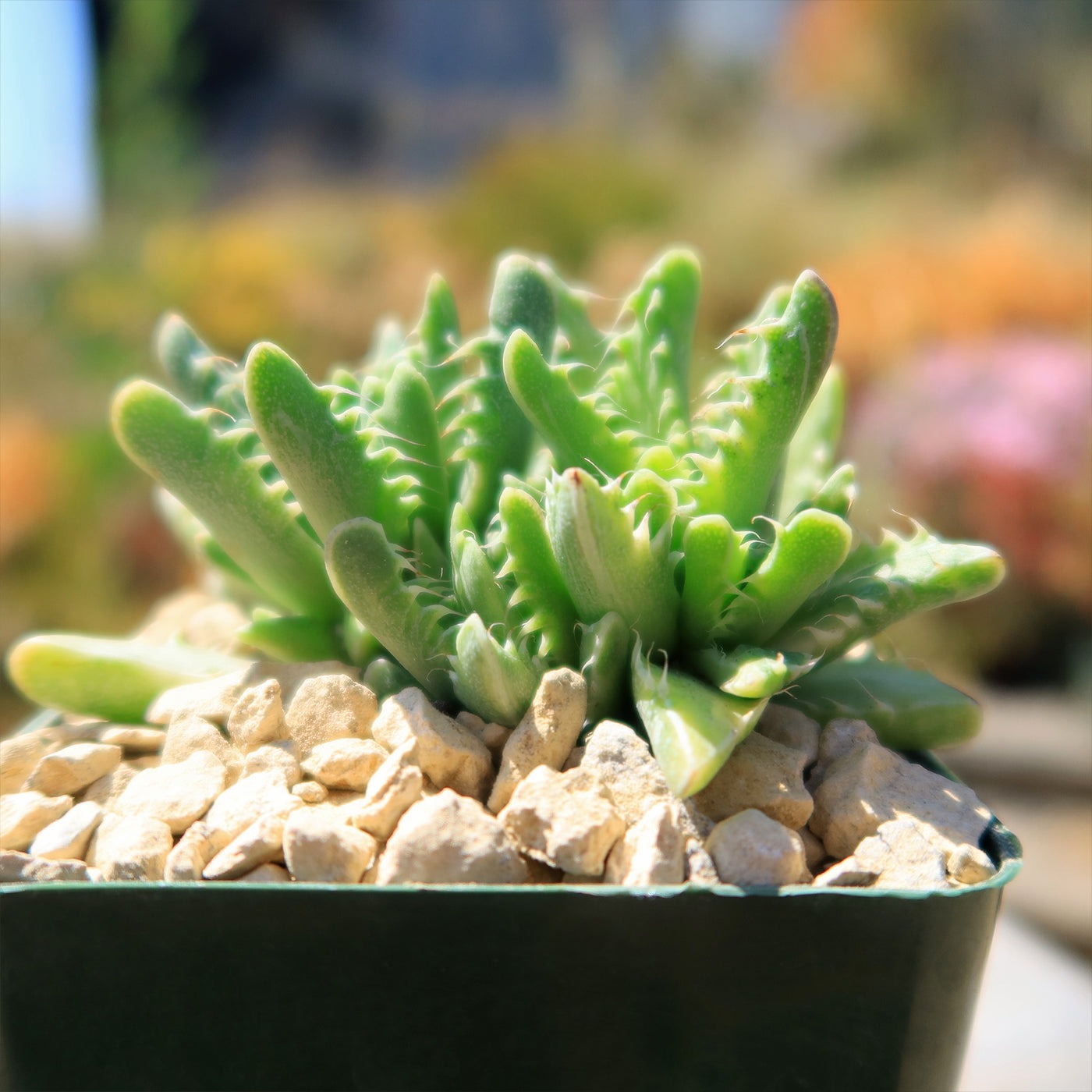
Tiger Jaws is a small, rosette-forming succulent with thick, triangular leaves lined with soft, tooth-like spines. These unique “jaws” help the plant retain moisture, and bright yellow flowers bloom in fall and winter.
It thrives in bright light and requires sandy, well-draining soil. Watering should be moderate, with the soil allowed to dry between sessions. It is semi-dormant in summer and needs less water during this period to prevent rot.
Ideal for USDA Zones 9-11, Tiger Jaws prefers warm, arid conditions but can be kept indoors in colder regions. It is well-suited for container gardening and rock gardens due to its distinctive appearance.
African Milk Tree (Euphorbia trigona)
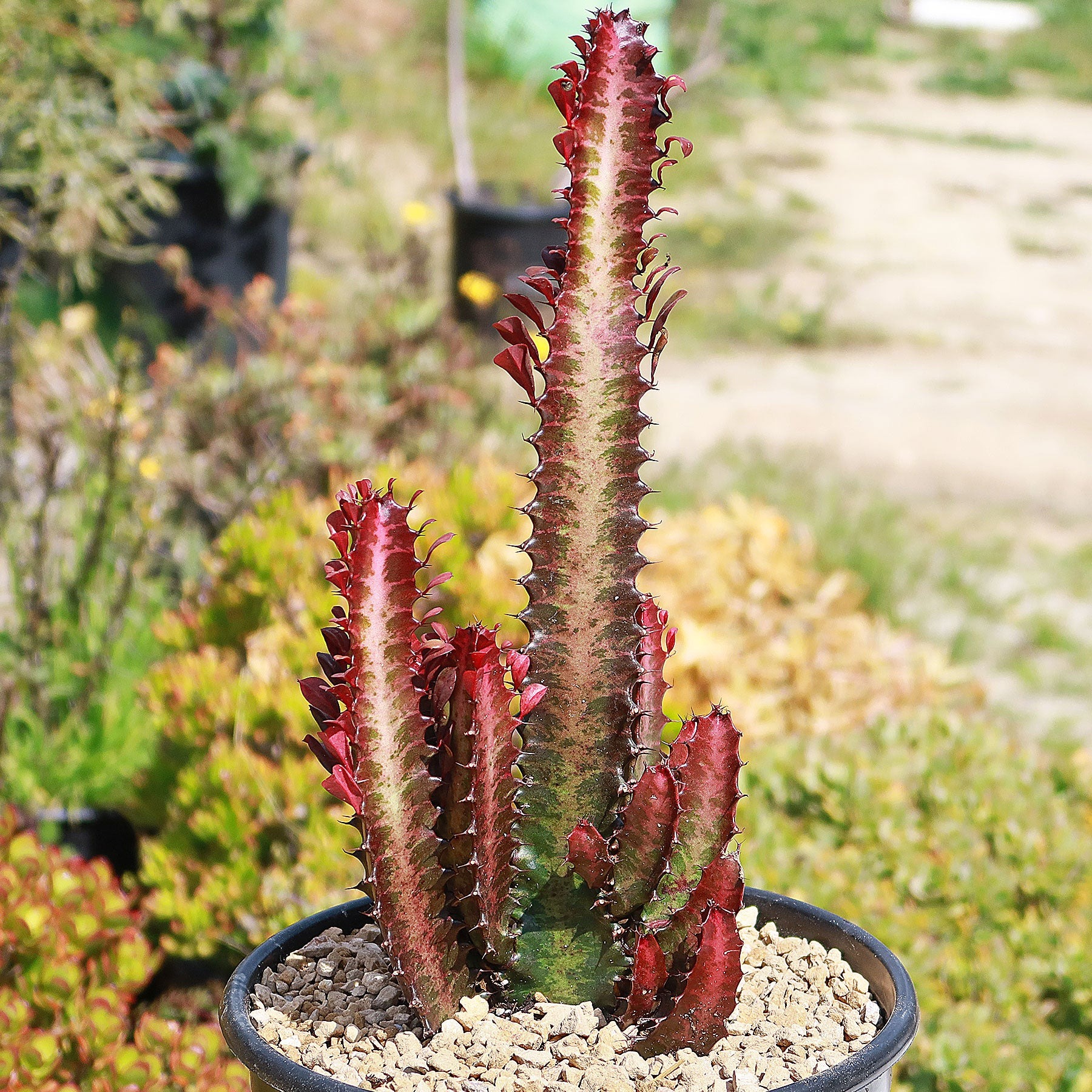
The African Milk Tree is a striking, fast-growing succulent with tall, green, columnar stems adorned with small spines and teardrop-shaped leaves. Over time, it develops a dense, shrubby appearance, making it a popular choice for decorative pots or outdoor landscapes in warm climates.
This plant thrives in bright, indirect light to full sun and prefers sandy, well-drained soil. Watering should be minimal, allowing the soil to dry out completely between sessions. Overwatering can cause root rot, so it’s best to keep it on the drier side.
Suitable for USDA Zones 9-11, the African Milk Tree can be grown outdoors in warm regions but should be brought indoors in colder climates. Its upright growth makes it an excellent structural accent in gardens and indoor spaces.
Burro’s Tail (Sedum morganianum)
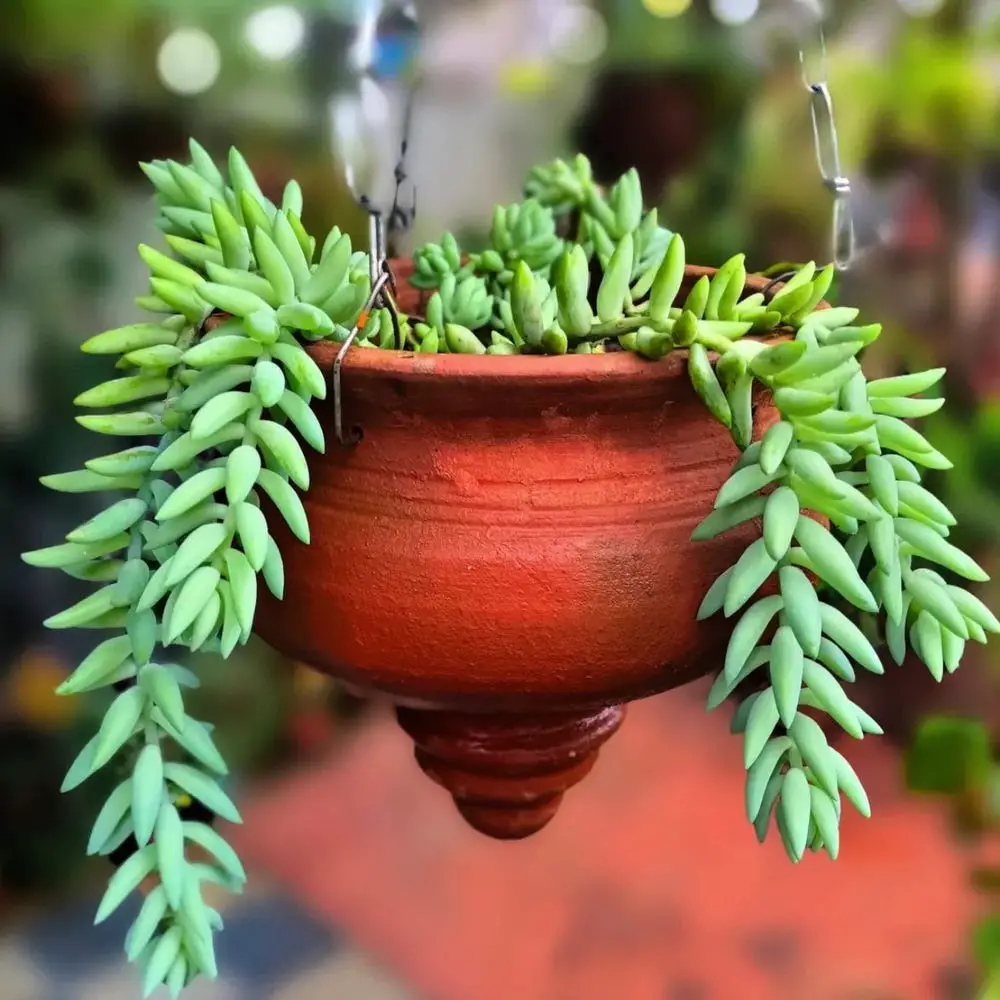
Burro’s Tail is a trailing succulent with long, cascading stems covered in plump, blue-green leaves shaped like teardrops. The delicate leaves are easily knocked off, so it’s best placed in a stable, undisturbed location.
It prefers full to partial sun and well-draining, sandy or loamy soil. Watering should be infrequent, as the plant stores moisture in its thick leaves. Overwatering can cause rot, while too little light may lead to stretched, leggy growth.
Ideal for USDA Zones 10-11, Burro’s Tail thrives in warm conditions and is best suited for hanging baskets or high shelves where its trailing stems can grow freely. In cooler climates, it should be kept indoors as a houseplant.
Rainbow Elephant Bush (Portulacaria afra ‘Variegata’)
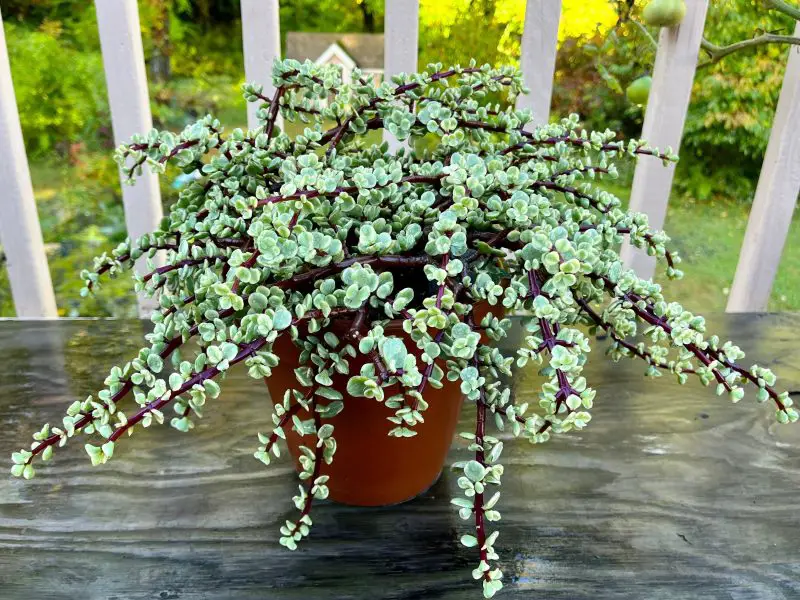
Rainbow Elephant Bush is a variegated succulent with small, round, green leaves edged in creamy white and pink. It has a bushy, spreading growth habit and is often used as a bonsai or in xeriscaping designs.
This plant thrives in bright, indirect light to full sun and requires sandy, well-drained soil. It is drought-tolerant and only needs occasional watering, with the soil allowed to dry between sessions. Overwatering can lead to root rot and leaf drop.
Best suited for USDA Zones 9-11, Rainbow Elephant Bush can be grown outdoors in warm climates or as a container plant indoors. Its colorful foliage makes it a standout addition to succulent collections and rock gardens.
Raven ZZ Plant (Zamioculcas zamiifolia ‘Raven’)
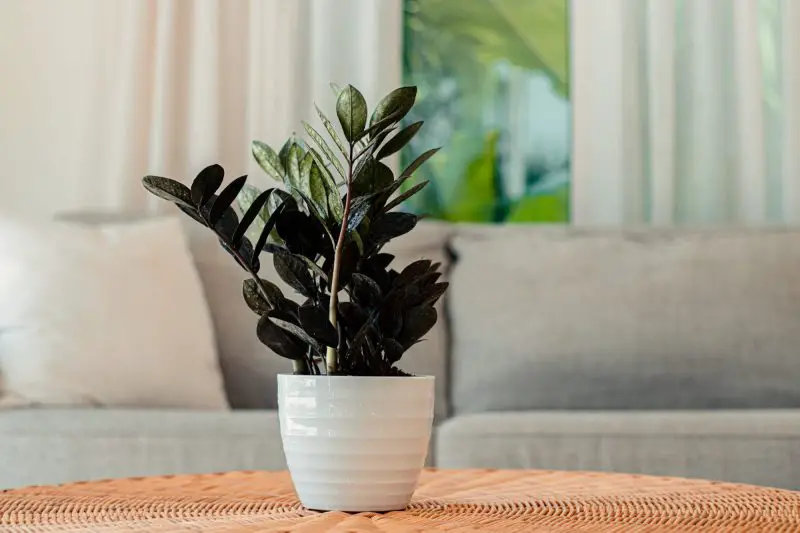
Raven ZZ Plant is a striking, low-maintenance succulent with glossy, deep purple-black leaves that emerge green before darkening with age. It has an upright growth habit and is prized for its modern, sculptural appearance.
It thrives in low to bright indirect light and requires well-draining soil, such as a cactus or succulent mix. Watering should be minimal, as it stores moisture in its rhizomes. Too much water can lead to root rot, making it more tolerant of neglect than overwatering.
Suitable for USDA Zones 9-11, Raven ZZ Plant is typically grown indoors as a houseplant. Its ability to tolerate low light and infrequent watering makes it an excellent choice for offices and homes with minimal maintenance needs.
Haworth’s Aeonium ‘Kiwi’ (Aeonium haworthii ‘Kiwi’)
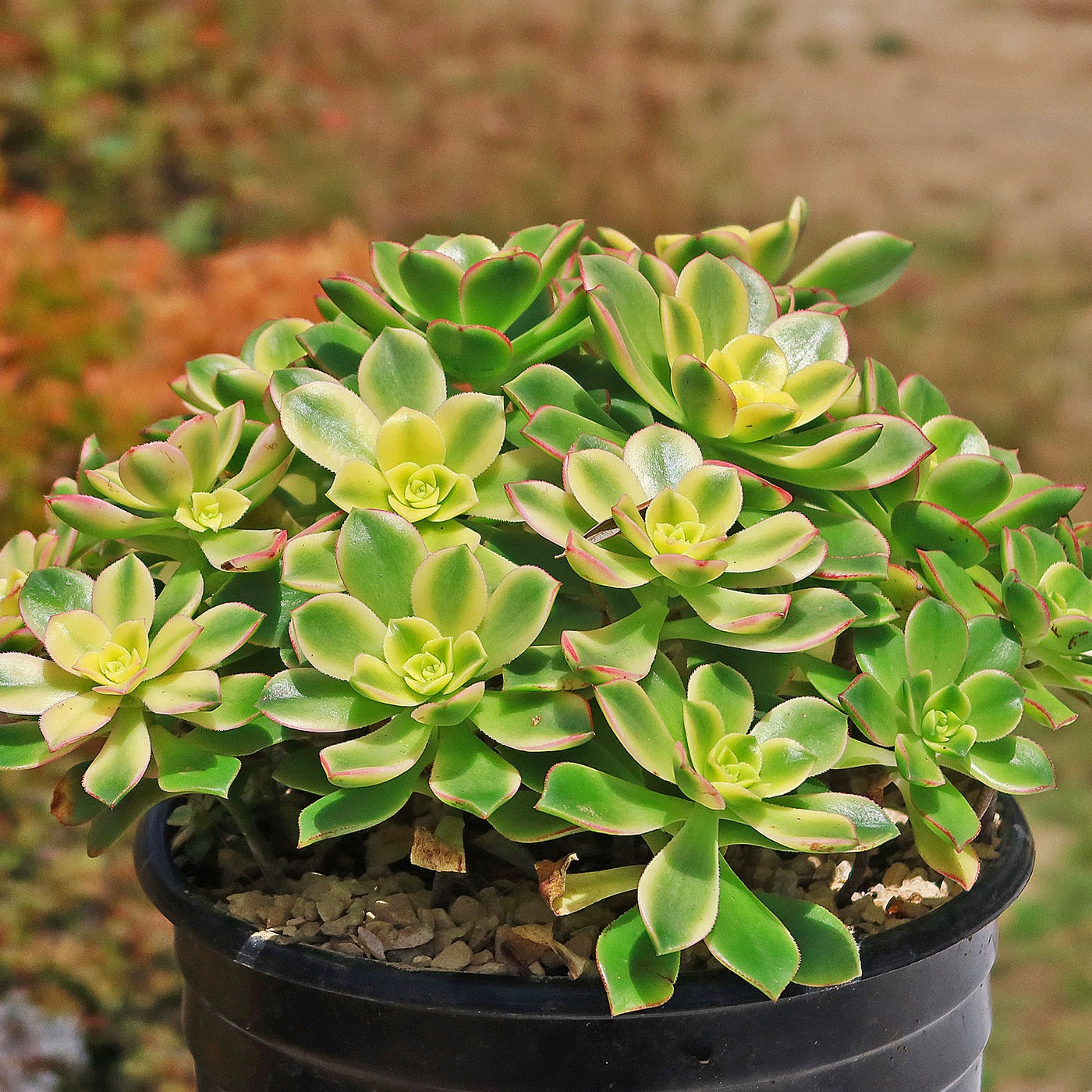
Haworth’s Aeonium ‘Kiwi’ is a colorful, rosette-forming succulent with green, yellow, and pink-tinged leaves that intensify in bright sunlight. It produces offsets readily, forming dense clusters over time.
This plant prefers full to partial sun and sandy, well-draining soil. Unlike many succulents, it has a winter growing season and may require slightly more water during active growth. However, overwatering should still be avoided to prevent rot.
Ideal for USDA Zones 9-11, Aeonium ‘Kiwi’ is a great choice for container gardens, rock gardens, and succulent arrangements. In colder climates, it should be brought indoors during freezing temperatures.
String of Hearts (Ceropegia woodii)
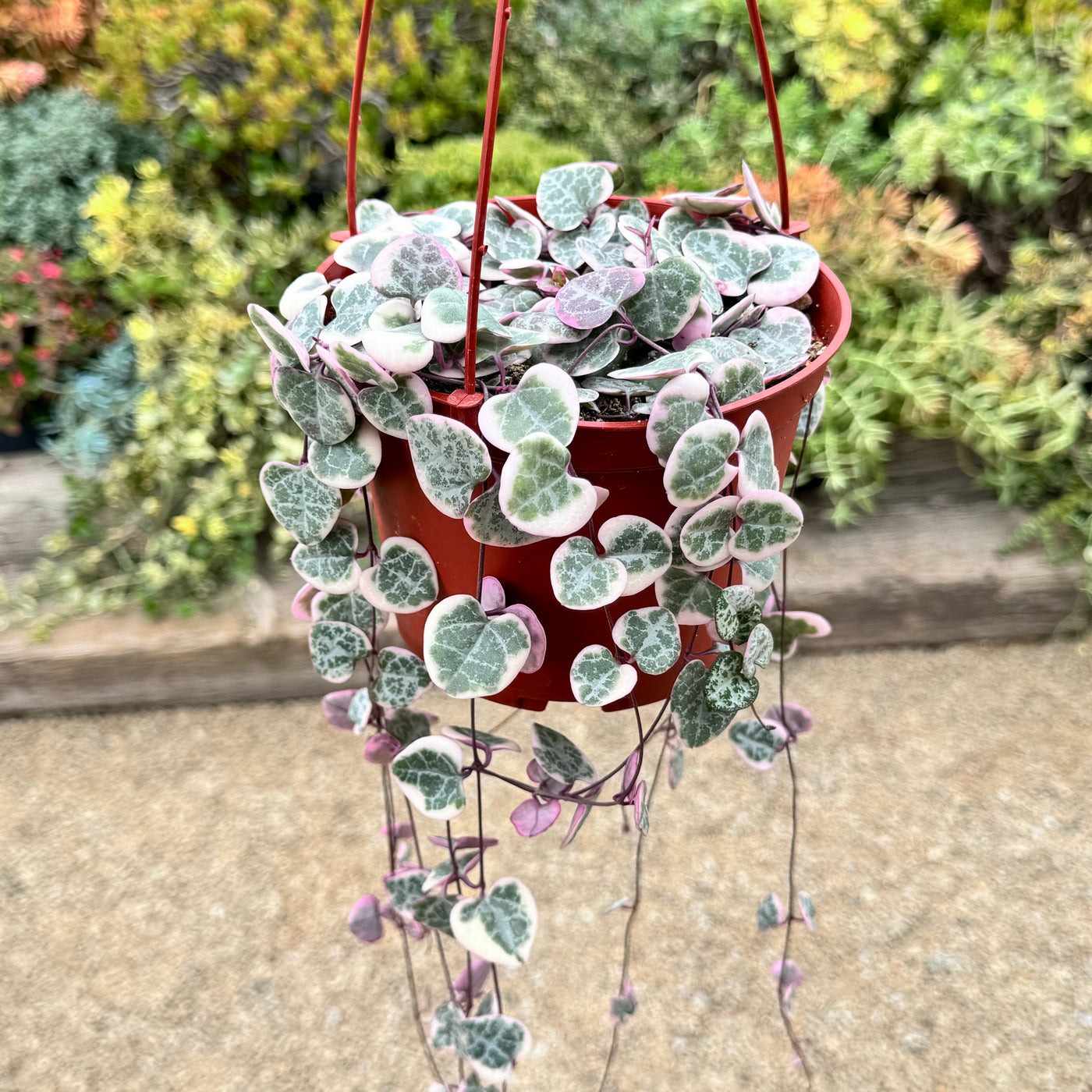
String of Hearts is a delicate, trailing succulent with long, wiry stems covered in small, heart-shaped leaves that have a marbled green and purple pattern. It produces tiny, tubular flowers in ideal conditions.
It thrives in bright, indirect light but can tolerate some direct sunlight. Well-draining soil is essential, and watering should be done sparingly, allowing the soil to dry out between sessions. Overwatering can cause root rot, while too little light may lead to leggy growth.
Best suited for USDA Zones 10-12, String of Hearts is often grown as a houseplant in cooler climates. Its trailing habit makes it perfect for hanging baskets or high shelves where its cascading vines can be displayed beautifully.
String of Dolphins (Senecio peregrinus)
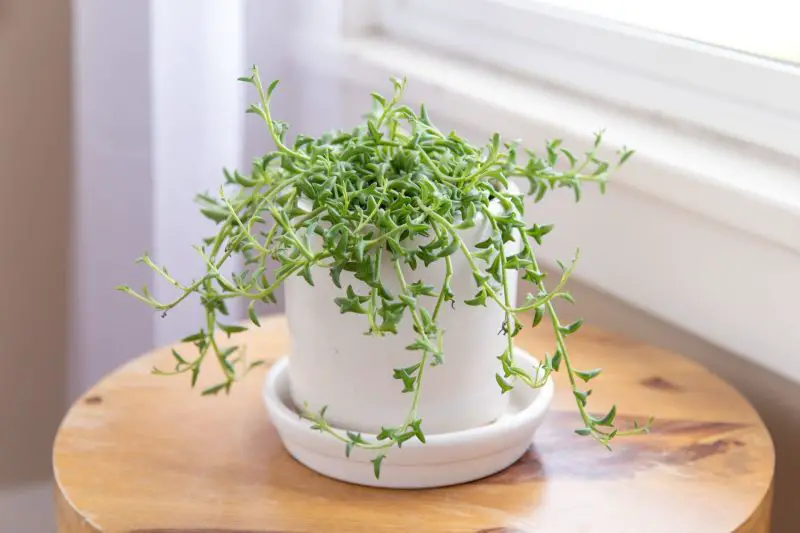
String of Dolphins is a unique trailing succulent with curved, plump leaves that resemble tiny leaping dolphins. This plant is a hybrid between String of Pearls and Candle Plant, making it a fascinating addition to any succulent collection.
It thrives in bright, indirect light and requires sandy, well-draining soil to prevent excess moisture buildup. Watering should be minimal, allowing the soil to dry completely between sessions. Overwatering can cause root rot, while too little light may lead to stretched, leggy growth.
Best suited for USDA Zones 10-12, String of Dolphins is commonly grown indoors in cooler climates. Its cascading vines make it perfect for hanging baskets or elevated planters where its playful foliage can be displayed.
String of Bananas (Curio radicans / Senecio radicans)

String of Bananas is a fast-growing trailing succulent with glossy, banana-shaped leaves. This plant is an excellent alternative to String of Pearls, as it is more resilient and easier to care for while still offering a cascading, decorative appearance.
It thrives in bright, indirect light to partial sun and prefers sandy, well-draining soil. Watering should be infrequent, allowing the soil to dry out completely before the next watering. Too much moisture can lead to root rot, while too little light may cause the stems to become sparse.
Ideal for USDA Zones 9-12, String of Bananas can be grown outdoors in warm climates or as a houseplant in cooler regions. It looks best in hanging baskets or containers where its trailing vines can grow freely.
Twisted-Leaf Yucca (Yucca rupicola)
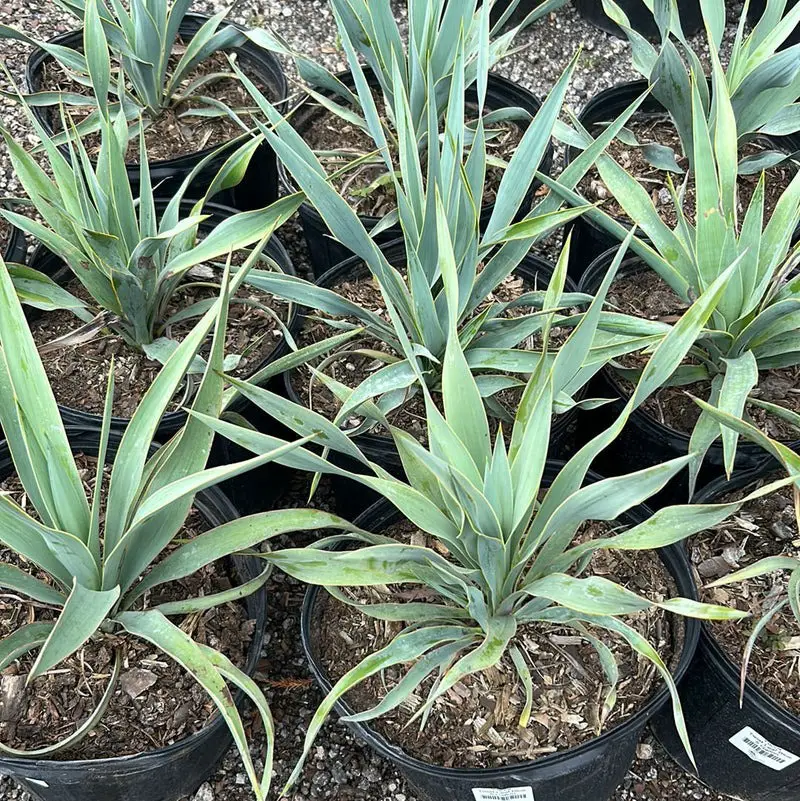
Twisted-Leaf Yucca is a hardy, drought-resistant plant with long, narrow green leaves that twist and curl as they grow, creating a distinctive, sculptural appearance. It forms a low, spreading rosette and can produce tall flowering spikes with creamy white blooms.
This plant thrives in full sun and requires sandy, well-drained soil to prevent root rot. It is highly drought-tolerant and only needs occasional deep watering. Overwatering should be avoided, as excess moisture can lead to fungal issues.
Best suited for USDA Zones 7-11, Twisted-Leaf Yucca is a great addition to rock gardens, xeriscapes, and arid landscapes. It is highly adaptable and can tolerate a wide range of temperatures, including light frost.
Arkansas Yucca (Yucca arkansana)
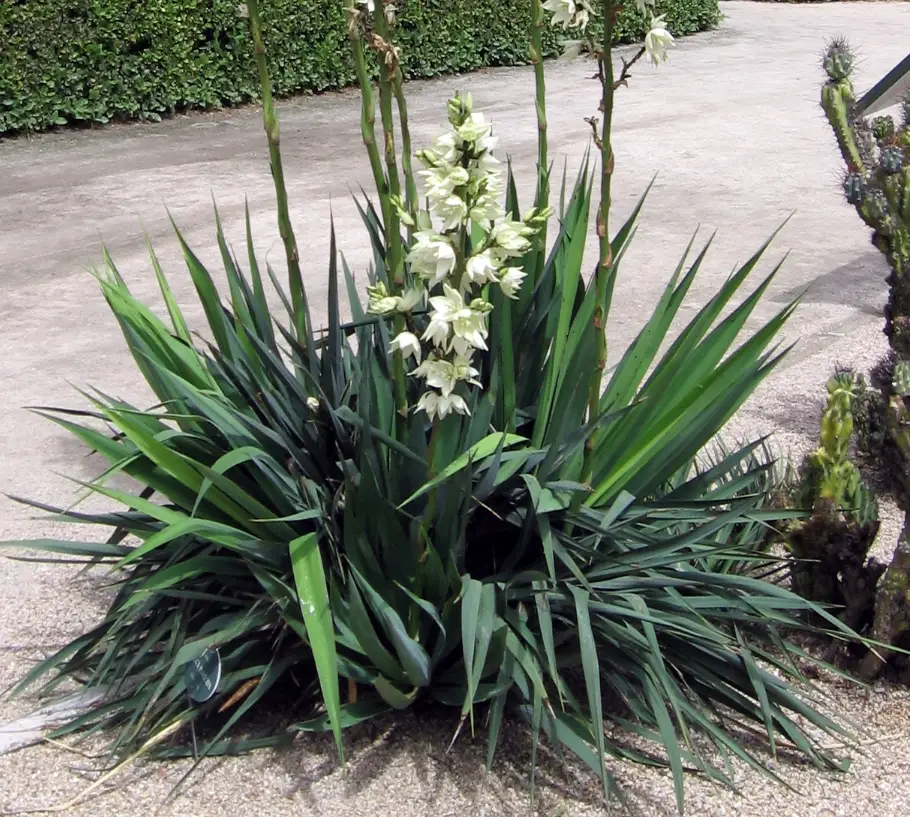
Arkansas Yucca is a tough, low-growing yucca species with slender, sword-like leaves that have sharp tips. It forms a compact rosette and produces tall flowering spikes with bell-shaped white flowers, attracting pollinators.
It thrives in full sun and prefers dry, well-draining soil. This yucca is exceptionally drought-tolerant and requires very little water once established. Overwatering can cause root rot, so it is best suited for dry, arid environments.
Ideal for USDA Zones 5-9, Arkansas Yucca is highly cold-hardy and can withstand harsh winters. It is often used in native plant gardens, xeriscaping, and rock gardens for its architectural appeal and resilience.
String of Turtles (Peperomia prostrata)
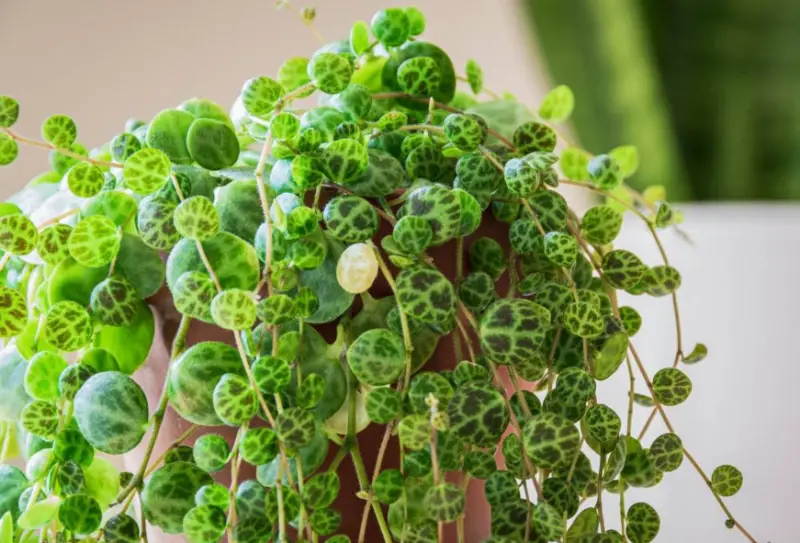
String of Turtles is a small, trailing houseplant with round, succulent-like leaves that have intricate, turtle-shell-like patterns. It is a slow-growing plant that thrives indoors, making it a favorite for terrariums and small-space gardening.
It prefers bright, indirect light and grows best in well-draining soil. Watering should be moderate, allowing the topsoil to dry between sessions. Unlike many succulents, String of Turtles enjoys slightly higher humidity levels, making it well-suited for indoor environments.
Best suited for USDA Zones 10-12, String of Turtles is primarily grown as a houseplant. Its trailing vines make it perfect for hanging baskets, small pots, or decorative arrangements.
Chinese Money Plant (Pilea peperomioides)
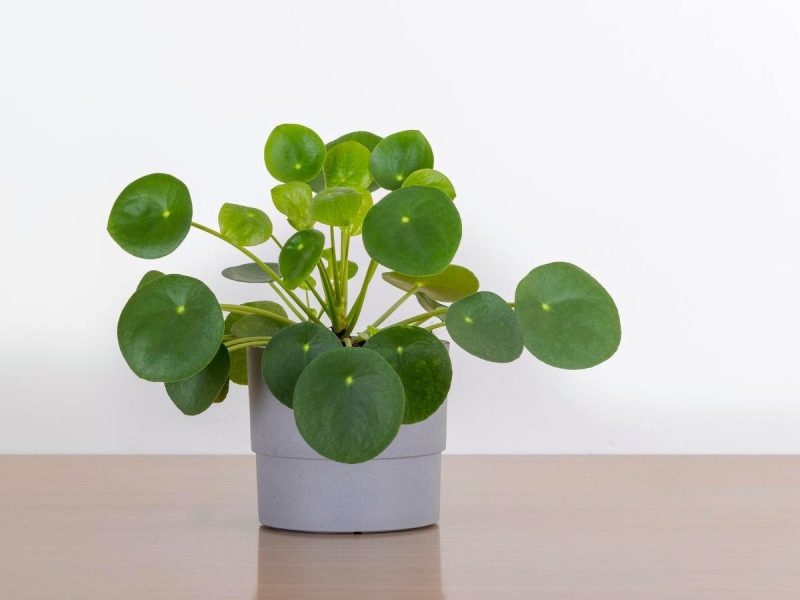
The Chinese Money Plant is a popular houseplant with round, coin-like green leaves on long, slender stems. It has a distinctive, modern appearance and is often associated with good fortune and prosperity.
It thrives in bright, indirect light but can tolerate lower light conditions. Well-draining soil is essential, and watering should be done when the topsoil feels dry. Overwatering can lead to root rot, while too much direct sun may scorch its delicate leaves.
Best suited for USDA Zones 9-11, the Chinese Money Plant is typically grown indoors as a houseplant. It is easy to propagate from its offsets, making it a favorite among plant enthusiasts looking to share cuttings with friends and family.
Dragon Fruit Cactus (Hylocereus undatus)

Dragon Fruit Cactus is a fast-growing, climbing cactus with long, fleshy green stems and large, fragrant white flowers that bloom at night. It produces the vibrant pink or yellow-skinned dragon fruit, known for its sweet, refreshing flesh.
This cactus thrives in full sun to partial shade and requires sandy, well-draining soil to prevent root rot. It needs regular watering during the growing season but should be allowed to dry out between sessions. Providing a trellis or support will help it climb and produce fruit efficiently.
Best suited for USDA Zones 10-12, Dragon Fruit Cactus grows well in warm, tropical climates. In cooler regions, it can be grown in containers and brought indoors during winter to protect it from frost.
Hindu Rope Plant (Hoya compacta)
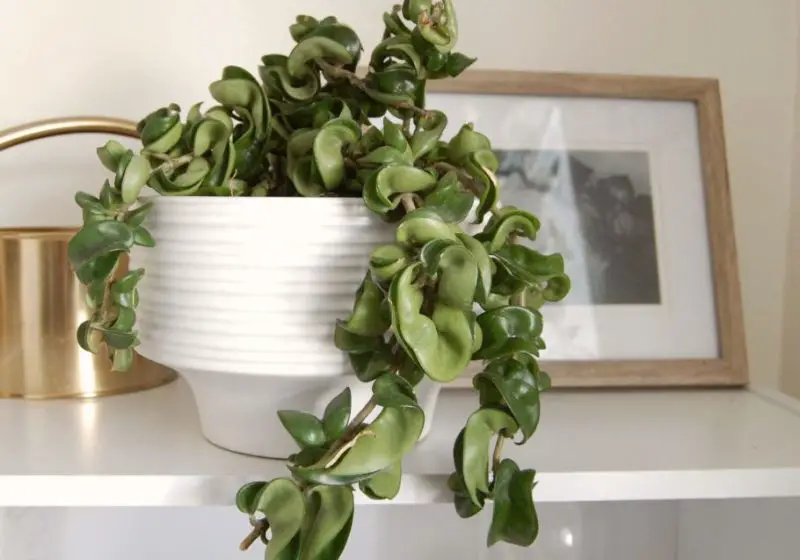
The Hindu Rope Plant is a unique trailing succulent with thick, twisted, waxy green leaves that curl along its vines. It is known for its fragrant, star-shaped flowers that grow in clusters, often appearing in shades of pink or white.
This plant prefers bright, indirect light and requires well-draining soil. Watering should be minimal, allowing the soil to dry between sessions. Due to its epiphytic nature, it benefits from occasional misting, especially in dry environments.
Suited for USDA Zones 10-12, the Hindu Rope Plant is commonly grown as a houseplant. Its cascading vines make it a beautiful choice for hanging baskets or decorative indoor planters.
Ghost Echeveria (Echeveria spp.)
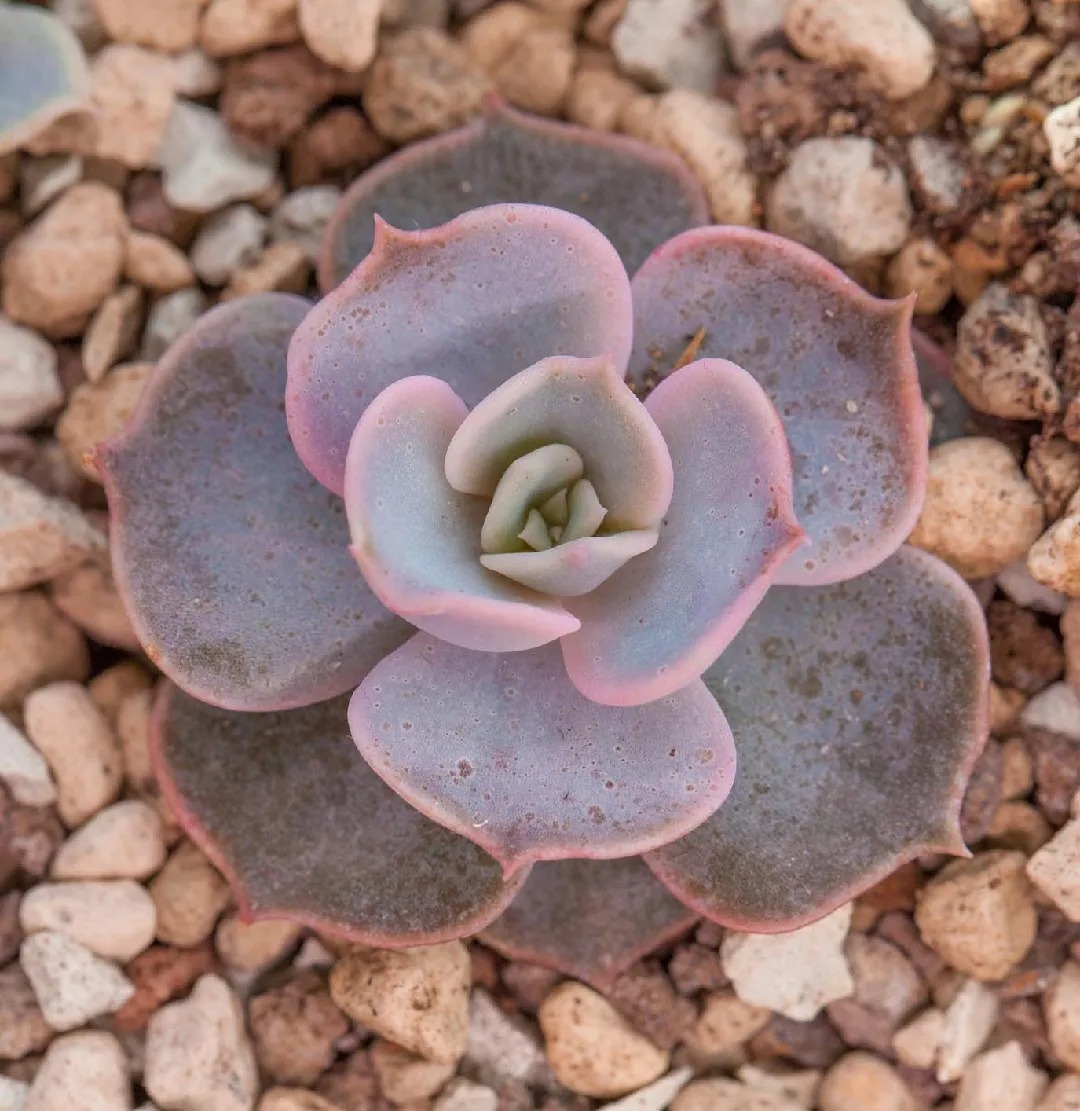
Ghost Echeveria is a striking rosette-forming succulent with pale, silvery-blue leaves that may develop a pinkish hue under strong sunlight. It produces tall, arching flower stalks with small, bell-shaped blooms.
This succulent thrives in full sun to partial shade and prefers well-draining, sandy soil. It requires minimal watering, with soil needing to dry completely between sessions. Too much moisture can cause root rot, making proper drainage essential.
Best suited for USDA Zones 9-11, Ghost Echeveria is ideal for rock gardens, container displays, and xeriscaping. It is commonly grown indoors in cooler climates where it can be protected from frost.
Mexican Firecracker (Echeveria setosa)
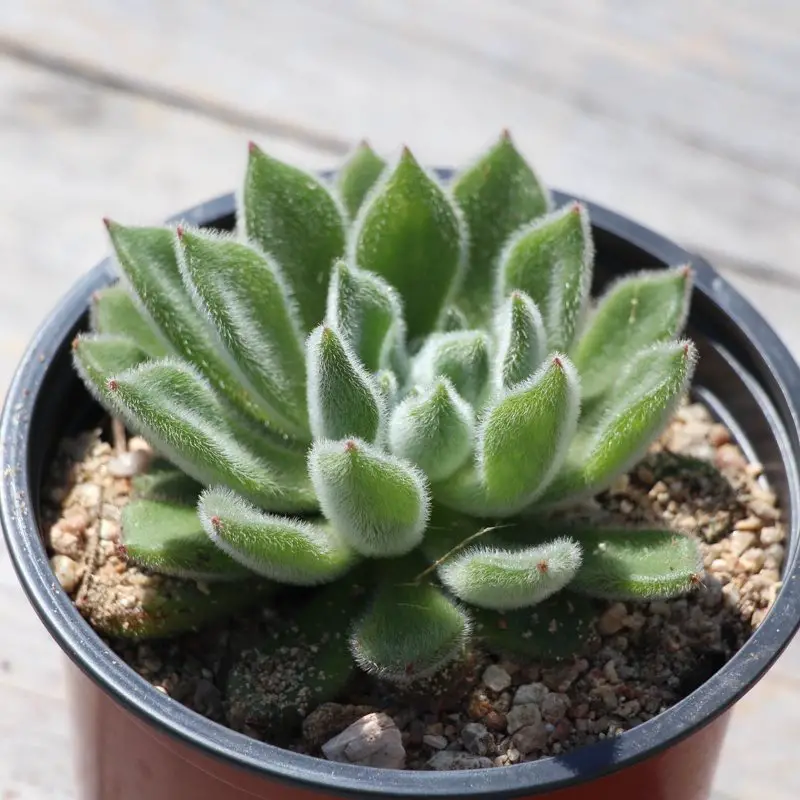
Mexican Firecracker is a compact succulent with densely packed, fuzzy green leaves covered in fine white hairs. During spring and summer, it produces bright red and yellow tubular flowers that attract pollinators.
This plant thrives in full sun to partial shade and prefers sandy, well-draining soil. Watering should be infrequent, allowing the soil to dry between sessions. Its fuzzy coating helps protect it from intense sunlight and water loss.
Best suited for USDA Zones 9-11, Mexican Firecracker is excellent for container gardening, rock gardens, or as an accent plant in succulent arrangements. It is sensitive to frost and should be brought indoors in colder regions.
Desert Rose (Adenium obesum)
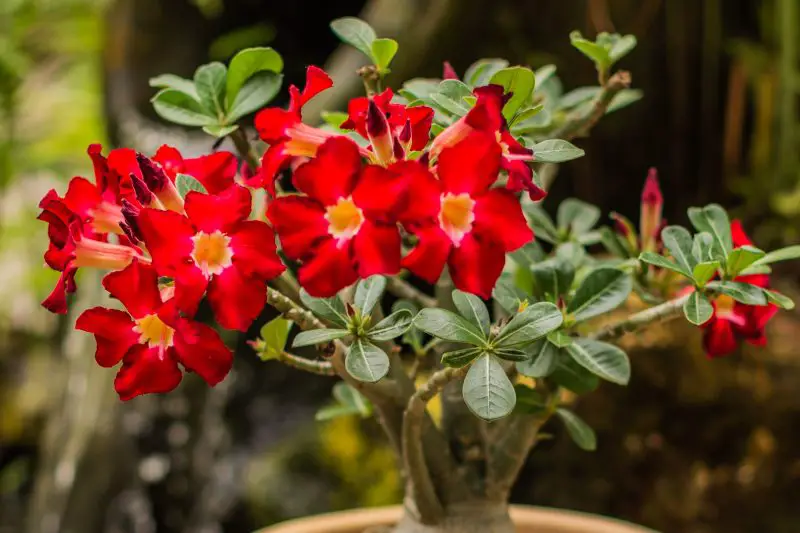
Desert Rose is a striking succulent shrub with a swollen, bulbous base and twisted branches. It produces showy, trumpet-shaped flowers in shades of pink, red, and white, blooming multiple times a year under ideal conditions.
It thrives in full sun and requires well-draining, sandy soil to prevent root rot. Watering should be minimal, with deep but infrequent watering to mimic its natural desert environment. Overwatering can cause the roots to rot, so the soil must dry out completely between sessions.
Best suited for USDA Zones 10-12, Desert Rose is ideal for warm, arid climates. In cooler regions, it can be grown in pots and brought indoors during winter. Proper pruning helps maintain its compact, sculptural shape.
Dwarf Jade (Portulacaria afra)
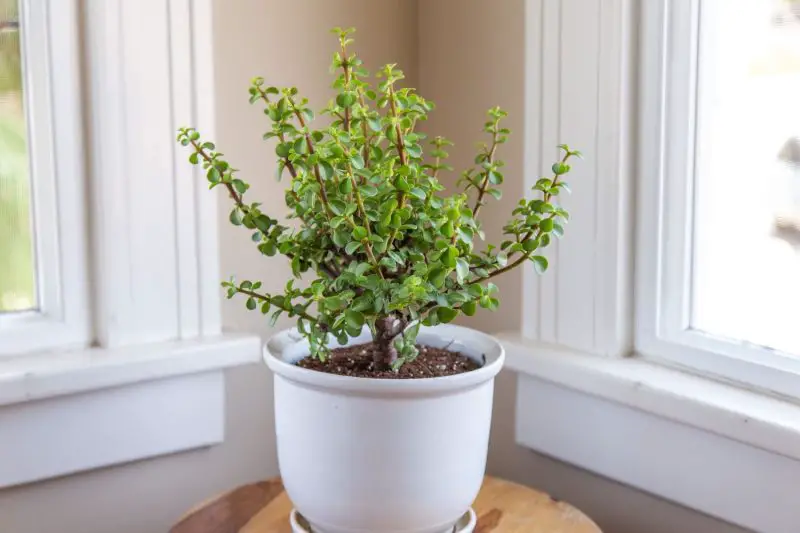
Dwarf Jade is a small, shrubby succulent with thick, woody stems and glossy, round green leaves. It is often mistaken for the Jade Plant (Crassula ovata) but has smaller, more delicate foliage. This plant is also used as a bonsai due to its naturally compact growth habit.
It prefers bright, indirect light to full sun and grows best in well-draining soil. Watering should be moderate, allowing the soil to dry completely between sessions. It is highly drought-tolerant and can withstand periods of neglect.
Suited for USDA Zones 9-11, Dwarf Jade is commonly grown as a houseplant or in rock gardens. It can be pruned to shape, making it a popular choice for bonsai enthusiasts and succulent collectors alike.
String Bean Hoya (Hoya shepherdii)
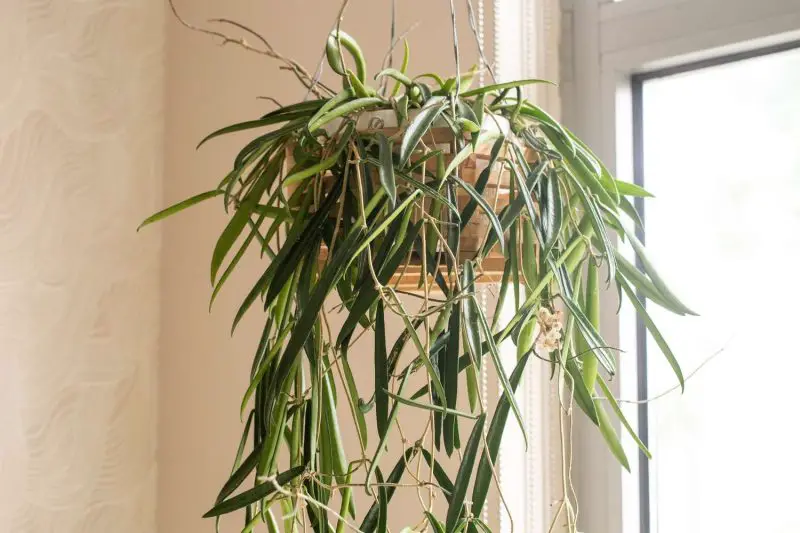
String Bean Hoya is a trailing succulent with long, narrow, deep green leaves resembling green beans. It produces clusters of star-shaped, fragrant flowers that range from white to pink.
This plant thrives in bright, indirect light and prefers well-draining soil. Watering should be minimal, allowing the soil to dry out between sessions. As an epiphytic species, it benefits from occasional misting, especially in dry indoor environments.
Best suited for USDA Zones 10-12, String Bean Hoya is commonly grown as a houseplant. Its cascading vines make it an excellent choice for hanging baskets or decorative indoor arrangements.
Gasteria (Gasteria spp.)
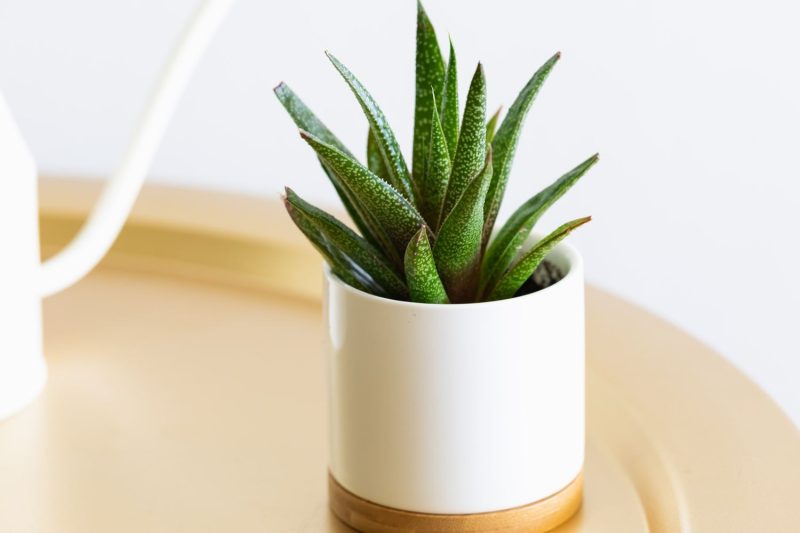
Gasteria is a slow-growing succulent with thick, fleshy, tongue-shaped leaves marked with spots or stripes. Some species produce curved flower spikes with small, tubular blooms that attract pollinators.
This plant thrives in bright, indirect light but can tolerate low-light conditions better than many succulents. It requires well-draining soil and infrequent watering, as excess moisture can lead to root rot.
Suited for USDA Zones 9-11, Gasteria is ideal for indoor containers and rock gardens. It can be grown outdoors in warm climates but should be protected from frost in colder regions.
Mistletoe Cactus (Rhipsalis baccifera)
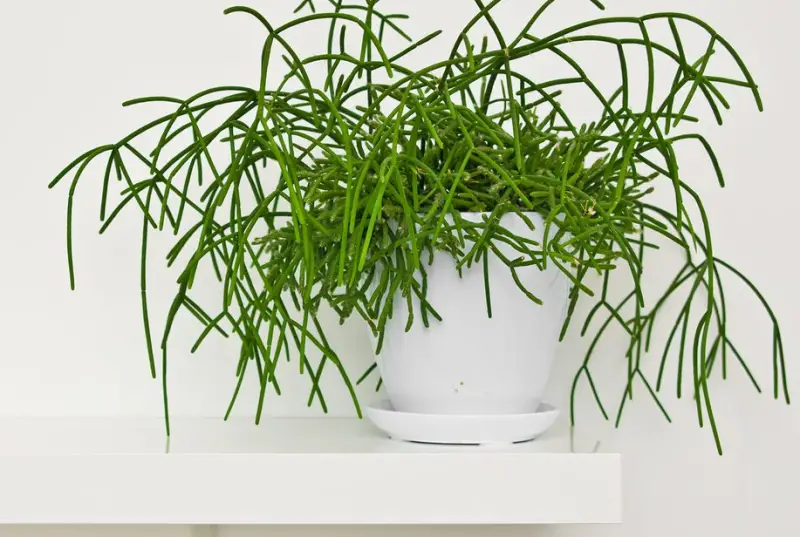
Mistletoe Cactus is a unique, trailing cactus with long, slender, green stems that grow in cascading clusters. Unlike desert cacti, it originates from tropical rainforests and lacks spines.
It prefers bright, indirect light and requires well-draining soil with moderate watering. Unlike many succulents, it enjoys slightly higher humidity and benefits from occasional misting.
Best suited for USDA Zones 9-12, Mistletoe Cactus makes a great houseplant. Its trailing growth makes it perfect for hanging baskets, and it can be grown outdoors in shaded areas in warmer climates.
Thanksgiving Cactus (Schlumbergera truncata)

Thanksgiving Cactus is a holiday-blooming succulent with segmented, flattened green stems and brightly colored, tubular flowers that appear in late fall. It is often confused with the Christmas Cactus but has sharper, pointed edges on its stem segments.
This cactus thrives in bright, indirect light and requires well-draining, slightly acidic soil. Watering should be moderate, allowing the topsoil to dry out before rewatering. It benefits from a period of cool temperatures to trigger blooming.
Best suited for USDA Zones 10-12, Thanksgiving Cactus is commonly grown indoors as a seasonal houseplant. It can also be placed outdoors in shaded areas during warm months.
Cape Aloe (Aloe ferox)
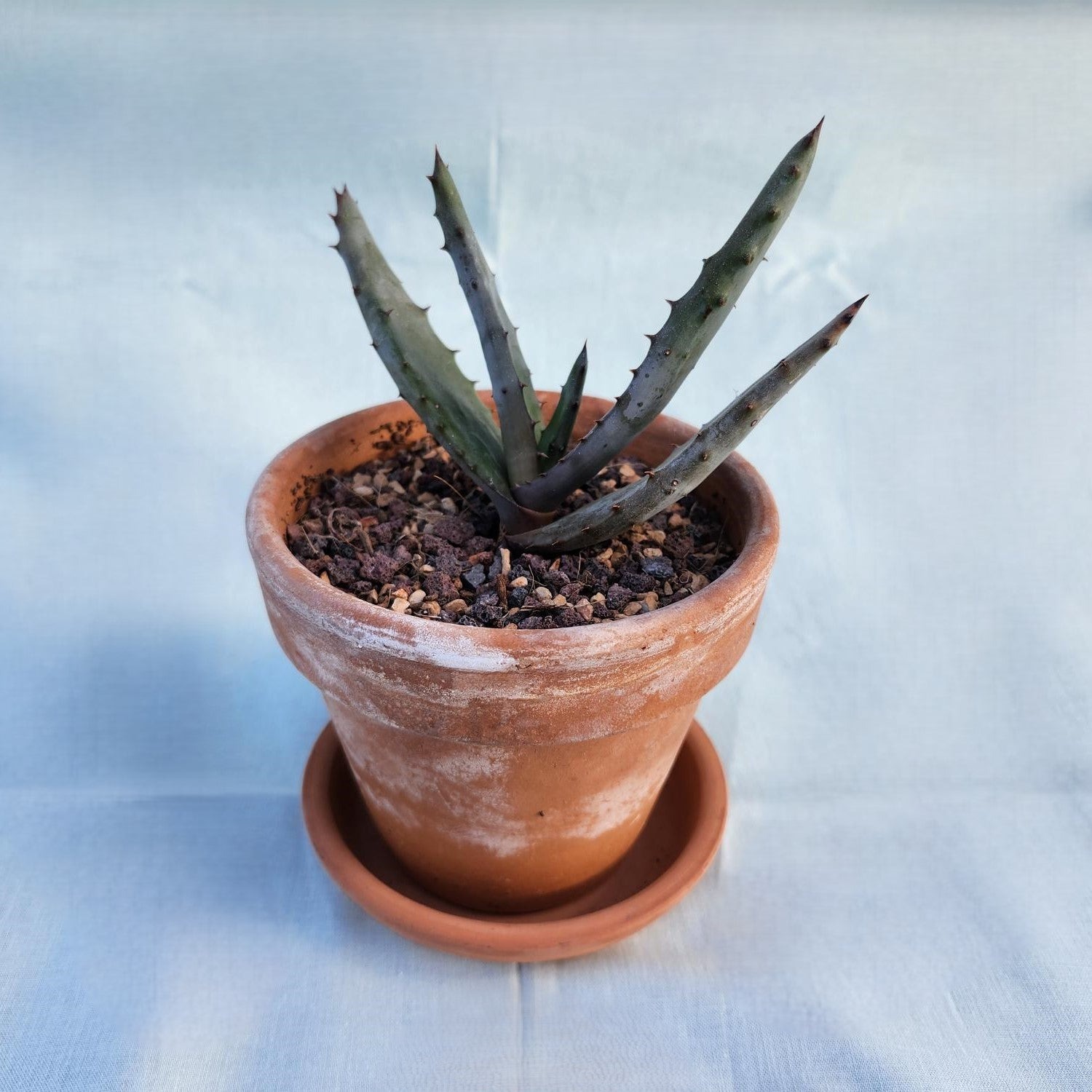
Cape Aloe is a large, striking succulent with thick, spiky leaves that turn reddish-brown under stress. It produces tall flower spikes with clusters of bright orange or red tubular blooms that attract pollinators.
This aloe thrives in full sun and requires sandy, well-draining soil. It is highly drought-tolerant and needs minimal watering, with long dry periods between sessions to prevent root rot.
Suited for USDA Zones 9-11, Cape Aloe is often used in xeriscaping, rock gardens, and as a medicinal plant. It can also be grown in containers and brought indoors in colder climates.
Hoya Kerrii (Hoya kerrii)
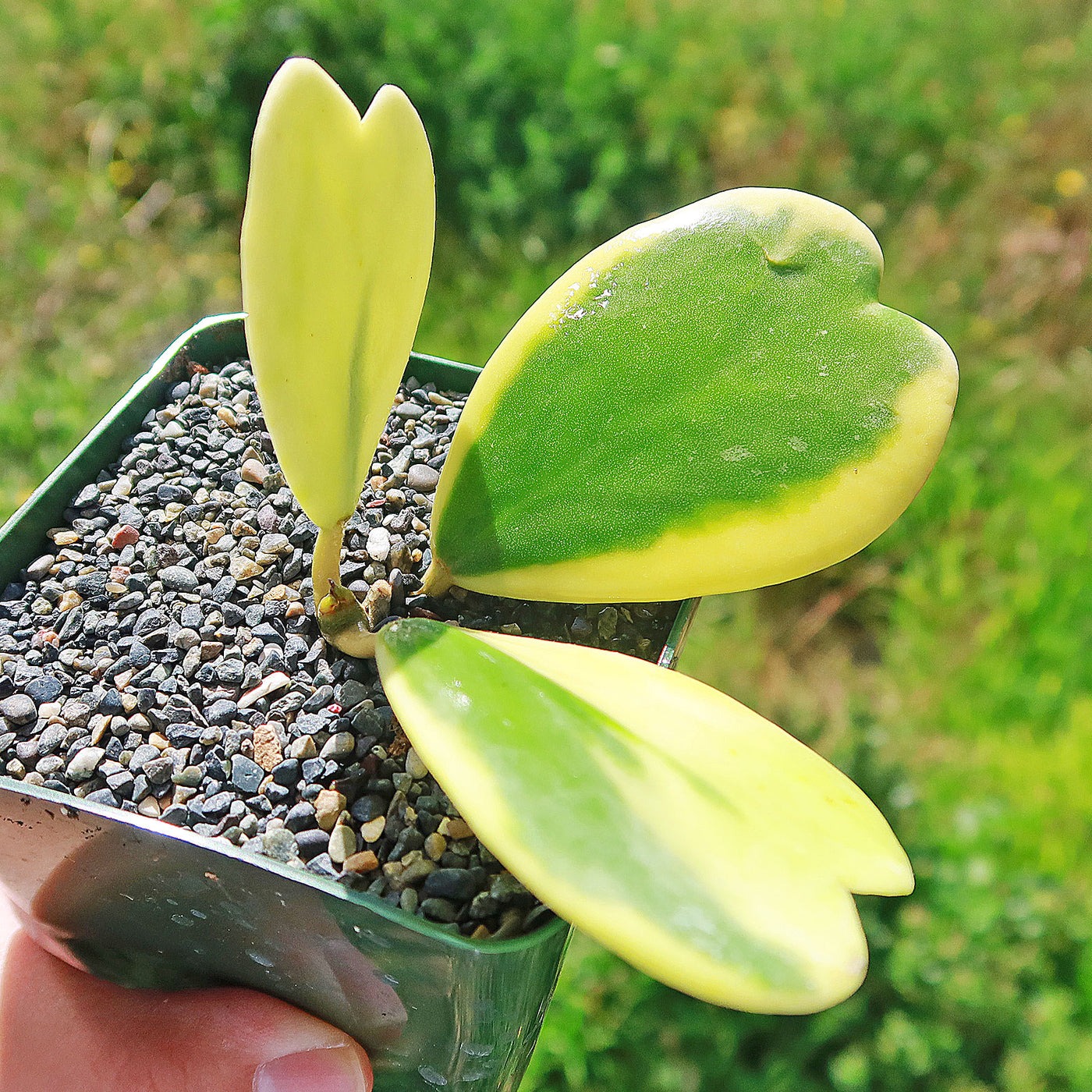
Hoya Kerrii, commonly called the Sweetheart Plant, is a slow-growing succulent with thick, heart-shaped leaves. It is often sold as a single leaf in small pots but can develop into a vining plant over time.
It prefers bright, indirect light and requires well-draining soil. Watering should be minimal, allowing the soil to dry out between sessions. As an epiphyte, it benefits from occasional misting in dry environments.
Best suited for USDA Zones 10-12, Hoya Kerrii is a popular houseplant. It is often gifted as a symbol of love and can be grown in hanging baskets or trained to climb with support.
Tiger Jaws (Faucaria tigrina)
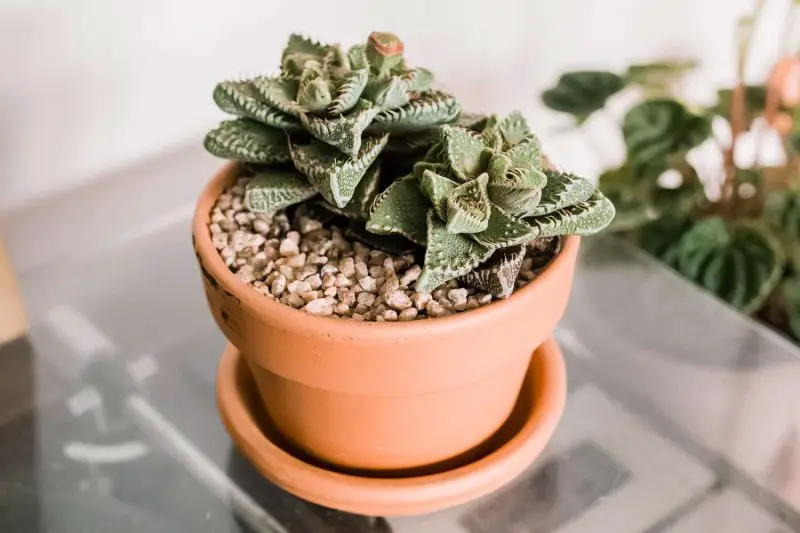
Tiger Jaws is a small, rosette-forming succulent with triangular green leaves edged with soft, tooth-like spines resembling an open jaw. It produces bright yellow, daisy-like flowers in the fall and winter.
This plant thrives in bright light and requires sandy, well-draining soil. Watering should be minimal, allowing the soil to dry between sessions. It benefits from a dry, cool winter dormancy to encourage flowering.
Best suited for USDA Zones 9-11, Tiger Jaws is perfect for rock gardens, succulent collections, or small pots. It is sensitive to frost and should be protected in colder climates.
Two-Row Stonecrop (Phedimus spurius / Sedum spurium)
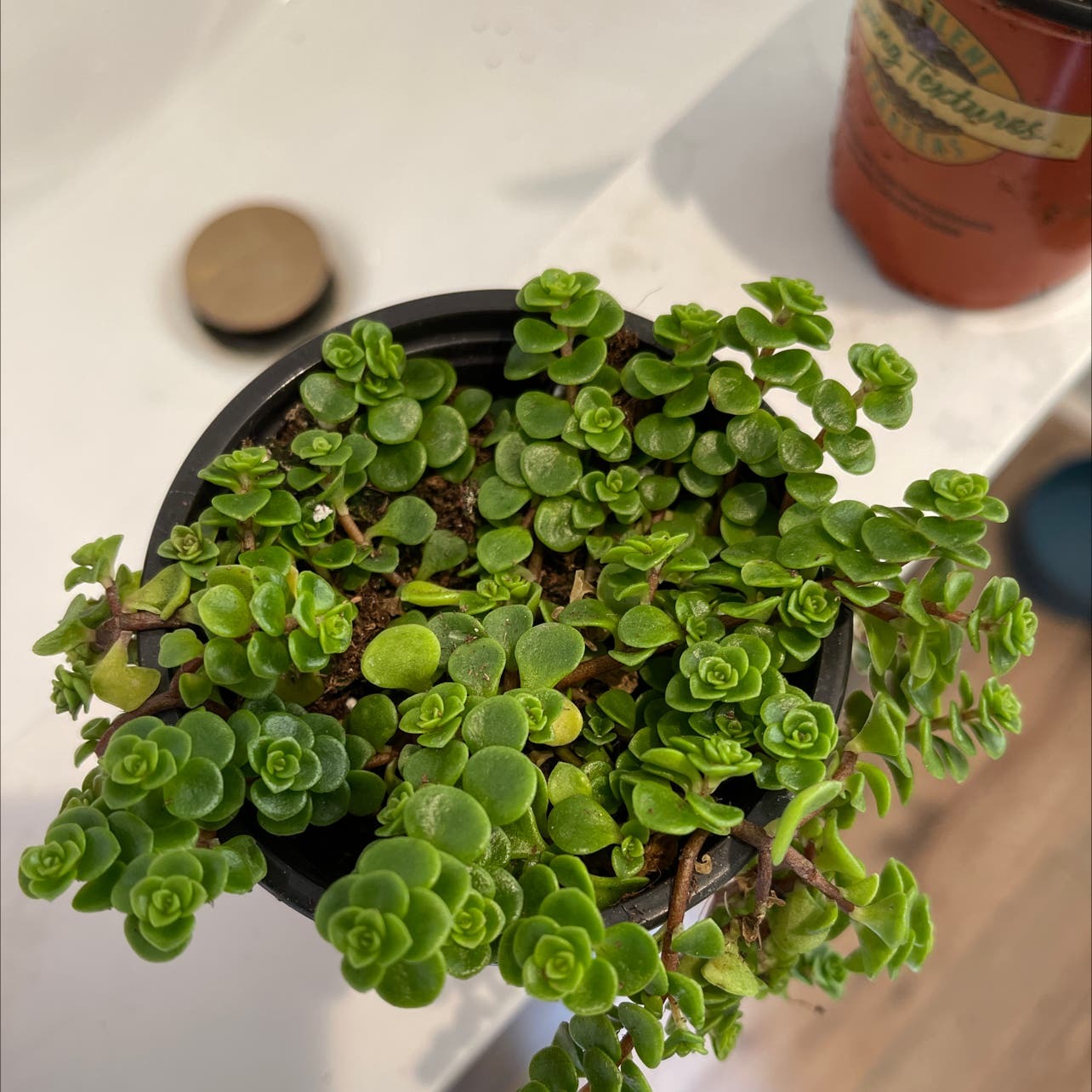
Two-Row Stonecrop is a low-growing, spreading succulent with fleshy, rounded green leaves that take on reddish hues in cooler weather. It produces clusters of small, star-shaped pink flowers in summer.
It thrives in full sun and prefers sandy, well-drained soil. This plant is highly drought-tolerant and requires little watering once established. It can spread quickly, making it a great ground cover.
Hardy in USDA Zones 3-9, Two-Row Stonecrop is excellent for rock gardens, borders, and green roofs. It can withstand cold winters, returning each spring with fresh growth.
‘Angelina’ Stonecrop (Sedum rupestre ‘Angelina’)
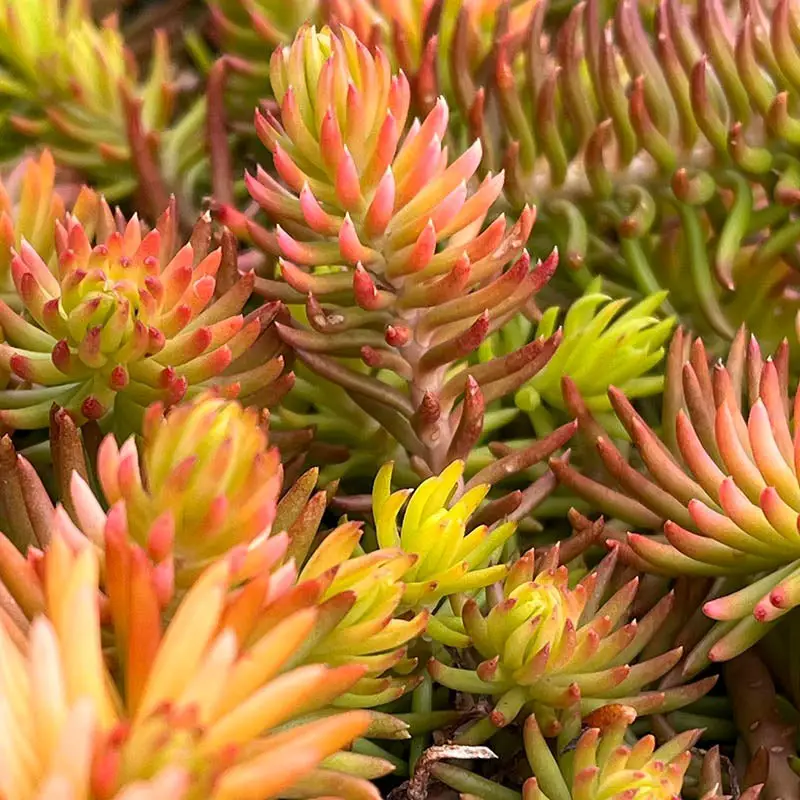
‘Angelina’ Stonecrop is a fast-spreading, low-growing succulent with needle-like, golden-yellow leaves that turn orange in cooler weather. It produces small yellow flowers in summer.
This plant thrives in full sun and well-draining soil. It is highly drought-tolerant and requires little maintenance, making it an excellent choice for xeriscaping.
Hardy in USDA Zones 3-11, ‘Angelina’ Stonecrop is widely used as ground cover, in rock gardens, or along borders. Its ability to withstand cold winters and heat makes it a versatile and resilient addition to any garden.
Orchid Cactus (Epiphyllum spp.)
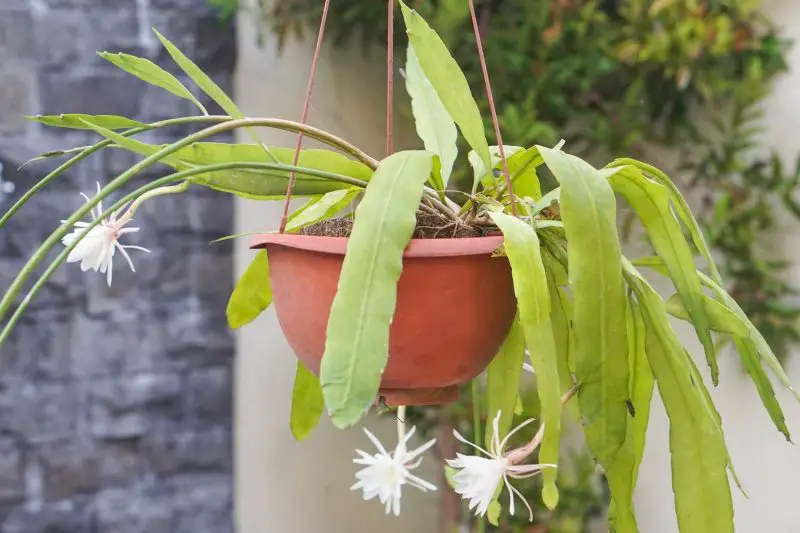
Orchid Cactus is an epiphytic succulent with long, flat, segmented green stems that cascade elegantly. It produces large, showy, fragrant flowers in vibrant colors such as pink, red, and white.
This plant prefers bright, indirect light and requires well-draining, organic-rich soil. It should be watered moderately, with the soil drying slightly between watering sessions. Higher humidity encourages better growth and flowering.
Best suited for USDA Zones 10-12, Orchid Cactus thrives as a houseplant or in shaded outdoor spaces. It is ideal for hanging baskets, where its trailing stems and blooms can be fully displayed.

